SCHEME OF WORK
WEEK TOPIC
1. Revision of first term work.
2. Cooperatives Societies in Agriculture: (a) Definition of an Agricultural cooperative society (b) Objectives of Agricultural cooperative Society (c) Types of Agricultural Cooperatives (d) Importance of Cooperative Societies
3. Management of Cooperative Societies in Agriculture: (a) How Cooperatives societies are formed (b) Management of Cooperative societies (c) Qualities of a good cooperative member.
4. Export Promotion in Agriculture: (a) Meaning of export promotion (b) Examples of Nigerian export produce (c) Importance of export promotion
5.Employment Opportunities in Agriculture : Self-employment in farming, Buying and selling farm produce, processing of farm produce, Paid employment in Government ministries or establishments, in Agro-based industries, in Banks and in Educational industries, etc.
6. Early Development of World Agriculture: Introduction, The Paleolithic Era, the Mesolithic Era, the Neolithic Era, the Agrarian (agric) revolution
7. School Farm: Meaning and importance of school farm, (school, students, community) principles of sitting school farm, problems of sitting school farm.
8. Farm Record: Importance of farm records, Types of farm records. e.g Farm Diary, Farm Inventory, Farm Account, etc.
9. Current Issues in African Agriculture: Food crisis in Africa; Hunger and poverty in Africa; Meeting the challenges of African food crisis, hunger and poverty; New Programmes in African Agriculture.
10. Agriculture and Health: Effects of HIV/AIDS and Malaria on Agricultural production.
11. Revision
2ND TERM
WEEK 1
LESSON 1
TOPIC: Cooperatives Societies in Agriculture:
CONTENTS: 1. Definition and Objectives of an Agricultural cooperative society
2. Types of Agricultural Cooperatives
3. Importance of Cooperative Societies
DEFINITION AND OBJECTIVES OF AN AGRICULTURAL COOPERATIVE SOCIETY
Introduction
Cooperative first started in England in 1844 by a group of textile workers called ''Rockdale Society of equitable pioneers''. The aims of forming the cooperative at that time were to raise enough capital to open a shop and exhibit their jointly and later create employment opportunities for their members by establishing a manufacturing company.
Definition of an Agricultural cooperative society
Agricultural cooperative or farmers cooperative is a business organization in which a group of individuals who have common interest agreed to pool their resources together for production or to distribute goods and services for the purpose of making profit and maintaining the welfare of members.

COOPERATIVE SOCIETIES IN AGRICULTURE
Agricultural cooperative society can be defined as a non-profit making business organisation formed by farmers
with then intention of rendering services to its members.
OBJECTIVES OF AGRICULTURAL COOPERATIVE - The main objectives of agricultural cooperative are
(i) To engage in thrift and credit operations
(ii) To stock and distribute farm inputs such as fertilizers, seeds and chemicals to framers.
(iii) To buy and distribute consumer commodities to then community at reasonable prices.
(iv) To engage in any agricultural undertaking.
(v) To undertake simple processing and marketing of cooperative farm products.
(vi) To act as manufacturers representatives.
(vii) To engage in export and import.
(viii) To operate transport services.
(ix) To make it easy for the dissemination of information to large number of farmers.
(x) To introduce farmers to and train them on new methods of farming.
(xi) To inculcate in the member group the spirit of unity and solidarity.
TYPES OF AGRICULTURAL COOPERATIVES
Agricultural cooperatives can be divided into the following types
(i) CONSUMERS COOPERATIVE – This type of cooperative are involved in buying goods in large quantities from
the producers or wholesalers at controlled price and sell the goods to their members at reduced price.
These undertake the distribution and marketing of agricultural goods and services. They buy consumer goods and sell them at market prices. They by-pass the middlemen in order to get these goods at cheaper rates and distribute to their members. They then share the profits among the financial members based on their rates of purchases from their stock.
(ii) PRODUCERS COOPERATIVE – A society concerned with solving the problems members encounter in their
farming. Different areas the society solve members’ problems include the purchase of farm inputs,
obtaining loans and hiring machines such as tractor for members” use.
This type of agricultural cooperative, apart from producing, undertakes the buying, storage, transportation and marketing of agricultural produce like cocoa, palm produce, rubber, coffee, etc. They usually buy from individual farmers who are members of the cooperatives, and from other sources.
They often sell to retailers and can undertake the exportation of such crops. Some cooperatives contribute money to buy or hire tractors and other farm inputs at reduced rates meant for promotion of farm activities.
(iii) MARKETING COOPERATIVE –This type of cooperative sells the members’ products. To get good price for
the members, the cooperative may carry out storage and transportation functions in order to get the
products tom buyers.
(iv) MULTIPURPOSE COOPERATIVE – These societies combine many functions ranging from producing crops to
processing and marketing of products for their members, credit acquisition for the benefit of members.
This type is varied in function. They can undertake bulk buying of farm inputs like fertilizers, farm implements etc. and sell to members at moderate prices. They also sell to non-members.
This society is mainly concerned with the marketing of members' produce for their benefits. They engage in purchase, storage, transportation and marketing of agricultural produce like cocoa, palm produce, coffee, rubber and other food crops which are supplied by the members.
(v) SAVING AND THRIFT SOCIETY – They act as financial institutions. Members contribute money either
weekly, monthly or yearly or at the end of each season to help each other. Members can obtain loans from
the cooperative with minimal interest rates.
These extend credits to their members as well as mobilize savings among their members. Members contribute money as shares; they give loans to members from such contributions. In some, members collect their total savings monthly, in rotation or at the end of the year.
IMPORTANCE OF COOPERATIVE SOCIETIES
1. They can move easily to obtain loans from banks than individual farmers.
2. They prevent hoarding, inflation and deflation.
3. They participate in production
4. They help to stabilize trade by their bulk buying and selling in small quantities at reduced prices.
5. They have higher bargaining power in marketing their farm produce than small scale individual farmers.
6. All the members have equal rights, and the pride of ownership makes them work hard for the success of the society.
7. They help farmers to form a saving habit through credit and thrift.
8. They improve the living standard of members.
9. Members acquire more knowledge, skills and experience through continuous agricultural extension education.
10. They help in marketing promotion by carrying out marketing functions.
[b]IMPORTANCE OF AGRICULTURAL COOPERATIVE SOCIETIES[/b]
(I) They assist member farmers to secure loans for inputs.
(II) They encourage cooperative farming.
(III) They provide processing, storage and marketing functions.
(IV) They help in the development of the community especially when they are located in the rural areas.
(V) They promote unity, love and team spirit in their members.
(VI) They heip to maximize the profit of their members since the profit of a cooperative society is not taxed.
(VII) They teach their members to meet high standards in their production so that they can export high quality
produce.
(VIII) They help their members to secure better prices for their produce.
(IX) They carry their members along in making decisions that affect the smooth running of the cooperative.
Evaluation
1. Briefly state the history of cooperative society – when, where and how it started.
2. What is an agricultural cooperative society?
3. List four types of agricultural cooperative societies
4. List three objectives of agricultural cooperative societies.
5. State five importance of agricultural cooperative societies.
Reading Assignment
Read about how Cooperatives societies are formed and managed.
Text: New Intensive Agricultural Science for Junior Secondary Schools pages (163-164)
Objective Test:
1. Which of the following is an objective of an agricultural cooperative society?
A. To build befitting houses for members
B. To pay the school fees of members only.
C. To receive savings from members
D. To advance loans to people generally for purposes of agriculture
2. Agricultural cooperatives are formed by people who have ----
A. huge capital B, commercial farms C. common interest D. management skills
3. Agricultural cooperative society that supplies technical services to her members is called ----- cooperative.
A. consumers' B. credit and C. multi-purpose D. producers'
4. Which of the following is not a farm produce that an agricultural cooperative society may buy and retail to its members?
A. Gold and other precious metals. B. milk and other milk products
C. meat and fish D. maize, rice and grain crops
5. Which of the following is not an agricultural cooperative society?
A. cocoa producers’ cooperative society B. produce buyers’ cooperative society
C. petroleum oil producers’ cooperative society D. Agricultural multipurpose cooperative society.
Essay Test:
1. Define Agricultural Cooperative Society
2. State three importance of agricultural cooperative societies
Reference Texts:
1. New Intensive Agricultural Science for Junior Secondary Schools by E.U Okaro.
2. Spectrum Agricultural Science for Junior Secondary Schools by B.A. Adelekan et'al.
3. Essentials of Agricultural Science for Junior Secondary Schools /Colleges in West Africa by Earnest Chukwudi Anie.
TOPIC: Cooperatives Societies in Agriculture:
CONTENTS: 1. Definition and Objectives of an Agricultural cooperative society
2. Types of Agricultural Cooperatives
3. Importance of Cooperative Societies
DEFINITION AND OBJECTIVES OF AN AGRICULTURAL COOPERATIVE SOCIETY
Introduction
Cooperative first started in England in 1844 by a group of textile workers called ''Rockdale Society of equitable pioneers''. The aims of forming the cooperative at that time were to raise enough capital to open a shop and exhibit their jointly and later create employment opportunities for their members by establishing a manufacturing company.
Definition of an Agricultural cooperative society
Agricultural cooperative or farmers cooperative is a business organization in which a group of individuals who have common interest agreed to pool their resources together for production or to distribute goods and services for the purpose of making profit and maintaining the welfare of members.

COOPERATIVE SOCIETIES IN AGRICULTURE
Agricultural cooperative society can be defined as a non-profit making business organisation formed by farmers
with then intention of rendering services to its members.
OBJECTIVES OF AGRICULTURAL COOPERATIVE - The main objectives of agricultural cooperative are
(i) To engage in thrift and credit operations
(ii) To stock and distribute farm inputs such as fertilizers, seeds and chemicals to framers.
(iii) To buy and distribute consumer commodities to then community at reasonable prices.
(iv) To engage in any agricultural undertaking.
(v) To undertake simple processing and marketing of cooperative farm products.
(vi) To act as manufacturers representatives.
(vii) To engage in export and import.
(viii) To operate transport services.
(ix) To make it easy for the dissemination of information to large number of farmers.
(x) To introduce farmers to and train them on new methods of farming.
(xi) To inculcate in the member group the spirit of unity and solidarity.
TYPES OF AGRICULTURAL COOPERATIVES
Agricultural cooperatives can be divided into the following types
(i) CONSUMERS COOPERATIVE – This type of cooperative are involved in buying goods in large quantities from
the producers or wholesalers at controlled price and sell the goods to their members at reduced price.
These undertake the distribution and marketing of agricultural goods and services. They buy consumer goods and sell them at market prices. They by-pass the middlemen in order to get these goods at cheaper rates and distribute to their members. They then share the profits among the financial members based on their rates of purchases from their stock.
(ii) PRODUCERS COOPERATIVE – A society concerned with solving the problems members encounter in their
farming. Different areas the society solve members’ problems include the purchase of farm inputs,
obtaining loans and hiring machines such as tractor for members” use.
This type of agricultural cooperative, apart from producing, undertakes the buying, storage, transportation and marketing of agricultural produce like cocoa, palm produce, rubber, coffee, etc. They usually buy from individual farmers who are members of the cooperatives, and from other sources.
They often sell to retailers and can undertake the exportation of such crops. Some cooperatives contribute money to buy or hire tractors and other farm inputs at reduced rates meant for promotion of farm activities.
(iii) MARKETING COOPERATIVE –This type of cooperative sells the members’ products. To get good price for
the members, the cooperative may carry out storage and transportation functions in order to get the
products tom buyers.
(iv) MULTIPURPOSE COOPERATIVE – These societies combine many functions ranging from producing crops to
processing and marketing of products for their members, credit acquisition for the benefit of members.
This type is varied in function. They can undertake bulk buying of farm inputs like fertilizers, farm implements etc. and sell to members at moderate prices. They also sell to non-members.
This society is mainly concerned with the marketing of members' produce for their benefits. They engage in purchase, storage, transportation and marketing of agricultural produce like cocoa, palm produce, coffee, rubber and other food crops which are supplied by the members.
(v) SAVING AND THRIFT SOCIETY – They act as financial institutions. Members contribute money either
weekly, monthly or yearly or at the end of each season to help each other. Members can obtain loans from
the cooperative with minimal interest rates.
These extend credits to their members as well as mobilize savings among their members. Members contribute money as shares; they give loans to members from such contributions. In some, members collect their total savings monthly, in rotation or at the end of the year.
IMPORTANCE OF COOPERATIVE SOCIETIES
1. They can move easily to obtain loans from banks than individual farmers.
2. They prevent hoarding, inflation and deflation.
3. They participate in production
4. They help to stabilize trade by their bulk buying and selling in small quantities at reduced prices.
5. They have higher bargaining power in marketing their farm produce than small scale individual farmers.
6. All the members have equal rights, and the pride of ownership makes them work hard for the success of the society.
7. They help farmers to form a saving habit through credit and thrift.
8. They improve the living standard of members.
9. Members acquire more knowledge, skills and experience through continuous agricultural extension education.
10. They help in marketing promotion by carrying out marketing functions.
[b]IMPORTANCE OF AGRICULTURAL COOPERATIVE SOCIETIES[/b]
(I) They assist member farmers to secure loans for inputs.
(II) They encourage cooperative farming.
(III) They provide processing, storage and marketing functions.
(IV) They help in the development of the community especially when they are located in the rural areas.
(V) They promote unity, love and team spirit in their members.
(VI) They heip to maximize the profit of their members since the profit of a cooperative society is not taxed.
(VII) They teach their members to meet high standards in their production so that they can export high quality
produce.
(VIII) They help their members to secure better prices for their produce.
(IX) They carry their members along in making decisions that affect the smooth running of the cooperative.
Evaluation
1. Briefly state the history of cooperative society – when, where and how it started.
2. What is an agricultural cooperative society?
3. List four types of agricultural cooperative societies
4. List three objectives of agricultural cooperative societies.
5. State five importance of agricultural cooperative societies.
Reading Assignment
Read about how Cooperatives societies are formed and managed.
Text: New Intensive Agricultural Science for Junior Secondary Schools pages (163-164)
Objective Test:
1. Which of the following is an objective of an agricultural cooperative society?
A. To build befitting houses for members
B. To pay the school fees of members only.
C. To receive savings from members
D. To advance loans to people generally for purposes of agriculture
2. Agricultural cooperatives are formed by people who have ----
A. huge capital B, commercial farms C. common interest D. management skills
3. Agricultural cooperative society that supplies technical services to her members is called ----- cooperative.
A. consumers' B. credit and C. multi-purpose D. producers'
4. Which of the following is not a farm produce that an agricultural cooperative society may buy and retail to its members?
A. Gold and other precious metals. B. milk and other milk products
C. meat and fish D. maize, rice and grain crops
5. Which of the following is not an agricultural cooperative society?
A. cocoa producers’ cooperative society B. produce buyers’ cooperative society
C. petroleum oil producers’ cooperative society D. Agricultural multipurpose cooperative society.
Essay Test:
1. Define Agricultural Cooperative Society
2. State three importance of agricultural cooperative societies
Reference Texts:
1. New Intensive Agricultural Science for Junior Secondary Schools by E.U Okaro.
2. Spectrum Agricultural Science for Junior Secondary Schools by B.A. Adelekan et'al.
3. Essentials of Agricultural Science for Junior Secondary Schools /Colleges in West Africa by Earnest Chukwudi Anie.
WEEK 2
LESSON 2
TOPIC: MANAGEMENT OF COOPERATIVE SOCIETIES IN AGRICULTURE
CONTENT: 1. How Cooperatives societies are formed
2. Management of Cooperative societies
3. Problems of Agricultural Cooperatives Societies
HOW COOPERATIVES SOCIETIES ARE FORMED
There are great differences between prices received by producers and those paid by consumers when they operate individually or as individual farmers. These differences make people having common interest seek protection by gathering together and pooling their resources to form a cooperative society.
Steps in forming a cooperative society
step 1: Individuals having common interest come together.
step 2: Such individuals identify their common goal or interest.
step 3: They agree to form a society.
step 4: They constitute a management committee and develop a bye-law or constitution to guide their activities.
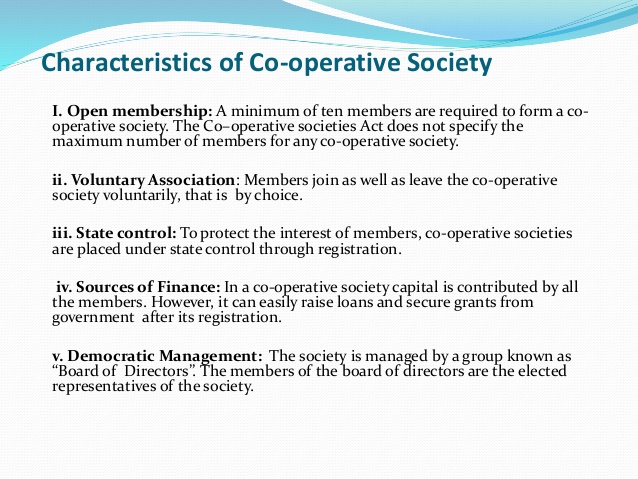
EVALUATION
List the steps for forming agricultural cooperative societies.
Further Study
LESSON 3
MANAGEMENT OF AGRICULTURAL COOPERATIVE SOCIETIES
After the formation of the society, the next step is management, that is:
1 To constitute a management committee. This committee (5 - 9 members) will then see to the day-to-day running of the activities and welfare of the society.
2. A constitution or bye-law for members will be drafted by appointed members.
3. A bank account will be opened for the society with about three signatories to the account.
4. The cooperative then registers with the Corporate Affairs Commission after due process. It is ready for registration when it has at least 10 members.
5. All members are then involved in the activities of the organization. They have equal voting right.
Members
I
Management committee chosen by members
I
Elected President
I
Appointed Secretary
I
Unit Managers
!
Other members
Management structure of a cooperative society
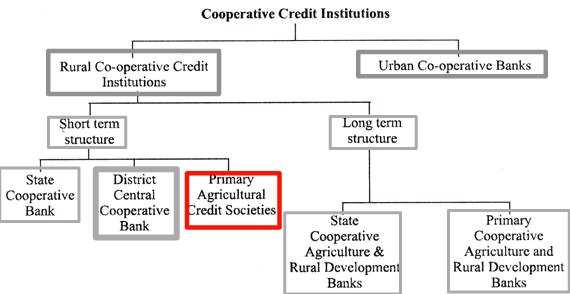
Qualities of a good cooperative member.
1. He must have team spirit,
2. He must show dedication to the cause of the group.
3. He must operate team player having good relationship with other members.
4. He must show selfless service and dedication.
5. He must be honest.
6. He must be fair but firm in his decision making.
Further Study
PROBLEMS OF AGRICULTURAL COOPERATIVES SOCIETIES
Despite the qualities of leaders and members of the cooperative societies, there are challenges facing the cooperative which include;
1. Inadequate capital.
2. Poor management resulting from lack of needed skills and experience.
3. Poor marketing system.
4. Embezzlement of the fund of the society by some dishonest leaders.
5. There is problem of repayment of loans by the beneficiaries.
6. Unstable policies and programmes of financial institutions and government.
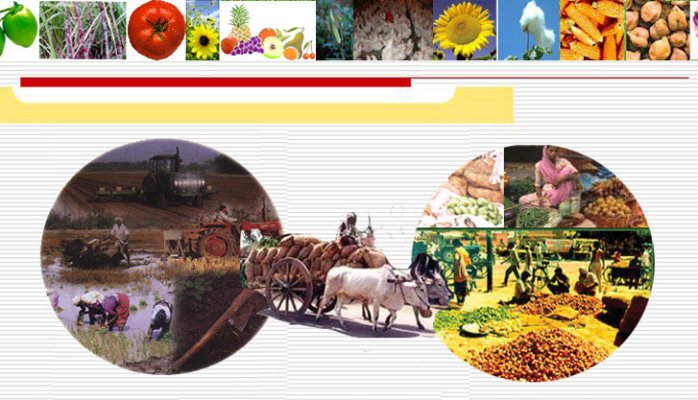

EVALUATION
1. Explain how an agricultural cooperative society is managed.
2. List four qualities of a good cooperative member.
3. Enumerate four problems of Agricultural Cooperative Societies.
Reading Assignment:
Read about export promotion in agriculture.
Text: Spectrum Agricultural Science for Junior Secondary Schools pages (45 - 48)
Objective Test:
1. The quality which makes a member of the team to always place the overall interest of the team above personal interest is known as ------------
A. group thinking B. teachable spirit C. team spirit D. dedication
2. ----- grants the cooperative society the right to exist and also be subject to the laws of the country.
A. ownership of an office B. Registration C communication D. selling of shares
3. Which of the following is not a desirable character attribute for a member of a cooperative society?
A. honesty B. loyalty C. frugality D. deceitfulness
4. Management is a ------- of production.
A. factor B. labour C. capital D. time
5. A document containing the fundamental laws and basic principles through which an organization is governed or run is called =========
A. ledger B. diary C. constitution D. minutes
Essay Test:
1. List three qualities of a good cooperative member.
2. (a) List 4 problems of Agricultural cooperative societies.
(b) Suggest solutions to these problems.
Reference Texts:
1. New Intensive Agricultural Science for Junior Secondary Schools by E.U Okaro.
2. Spectrum Agricultural Science for Junior Secondary Schools by B.A. Adelekan et'al.
3. Essentials of Agricultural Science for Junior Secondary Schools /Colleges in West Africa by Earnest Chukwudi Anie.
TOPIC: MANAGEMENT OF COOPERATIVE SOCIETIES IN AGRICULTURE
CONTENT: 1. How Cooperatives societies are formed
2. Management of Cooperative societies
3. Problems of Agricultural Cooperatives Societies
HOW COOPERATIVES SOCIETIES ARE FORMED
There are great differences between prices received by producers and those paid by consumers when they operate individually or as individual farmers. These differences make people having common interest seek protection by gathering together and pooling their resources to form a cooperative society.
Steps in forming a cooperative society
step 1: Individuals having common interest come together.
step 2: Such individuals identify their common goal or interest.
step 3: They agree to form a society.
step 4: They constitute a management committee and develop a bye-law or constitution to guide their activities.

EVALUATION
List the steps for forming agricultural cooperative societies.
Further Study
LESSON 3
MANAGEMENT OF AGRICULTURAL COOPERATIVE SOCIETIES
After the formation of the society, the next step is management, that is:
1 To constitute a management committee. This committee (5 - 9 members) will then see to the day-to-day running of the activities and welfare of the society.
2. A constitution or bye-law for members will be drafted by appointed members.
3. A bank account will be opened for the society with about three signatories to the account.
4. The cooperative then registers with the Corporate Affairs Commission after due process. It is ready for registration when it has at least 10 members.
5. All members are then involved in the activities of the organization. They have equal voting right.
Members
I
Management committee chosen by members
I
Elected President
I
Appointed Secretary
I
Unit Managers
!
Other members
Management structure of a cooperative society

Qualities of a good cooperative member.
1. He must have team spirit,
2. He must show dedication to the cause of the group.
3. He must operate team player having good relationship with other members.
4. He must show selfless service and dedication.
5. He must be honest.
6. He must be fair but firm in his decision making.
Further Study
PROBLEMS OF AGRICULTURAL COOPERATIVES SOCIETIES
Despite the qualities of leaders and members of the cooperative societies, there are challenges facing the cooperative which include;
1. Inadequate capital.
2. Poor management resulting from lack of needed skills and experience.
3. Poor marketing system.
4. Embezzlement of the fund of the society by some dishonest leaders.
5. There is problem of repayment of loans by the beneficiaries.
6. Unstable policies and programmes of financial institutions and government.


EVALUATION
1. Explain how an agricultural cooperative society is managed.
2. List four qualities of a good cooperative member.
3. Enumerate four problems of Agricultural Cooperative Societies.
Reading Assignment:
Read about export promotion in agriculture.
Text: Spectrum Agricultural Science for Junior Secondary Schools pages (45 - 48)
Objective Test:
1. The quality which makes a member of the team to always place the overall interest of the team above personal interest is known as ------------
A. group thinking B. teachable spirit C. team spirit D. dedication
2. ----- grants the cooperative society the right to exist and also be subject to the laws of the country.
A. ownership of an office B. Registration C communication D. selling of shares
3. Which of the following is not a desirable character attribute for a member of a cooperative society?
A. honesty B. loyalty C. frugality D. deceitfulness
4. Management is a ------- of production.
A. factor B. labour C. capital D. time
5. A document containing the fundamental laws and basic principles through which an organization is governed or run is called =========
A. ledger B. diary C. constitution D. minutes
Essay Test:
1. List three qualities of a good cooperative member.
2. (a) List 4 problems of Agricultural cooperative societies.
(b) Suggest solutions to these problems.
Reference Texts:
1. New Intensive Agricultural Science for Junior Secondary Schools by E.U Okaro.
2. Spectrum Agricultural Science for Junior Secondary Schools by B.A. Adelekan et'al.
3. Essentials of Agricultural Science for Junior Secondary Schools /Colleges in West Africa by Earnest Chukwudi Anie.
WEEK 3
LESSON 4
TOPIC: EXPORT PROMOTION IN AGRICULTURE
CONTENT: (a) Meaning of export promotion
(b) Examples of Nigerian export produce
(c) Importance of export promotion
MEANING OF EXPORT AND EXPORT PROMOTION
Export: is the selling of goods and services across the national boundaries of other countries. A person or country that does this is an exporter.
Export promotion: is a set of activities that brings about increase in the sale of agricultural produce to other nations. It also refers to encouraging the sale of Nigerian produce in other countries. The Nigerian climate favours the production of certain crops and animals products above some other countries of the world, hence, the need to encourage the exportation of these crops to other countries to gain foreign exchange which will be used to import other goods that we need.


The activities that constitute export promotion include:
i. Identification of products and markets.
ii. Location of new investment opportunities.
iii. Supply trade information.
iv. Provision of support services.
v. Organizing trade fairs and trade missions.
EXAMPLES OF NIGERIAN EXPORT PRODUCE
The Nigerian export produce includes:
i. palm produce
ii. Cocoa
iii. Coffee
iv. Soyabeans
v. Hides and skin
vi. Groundnut
vii. Ginger
viii. Maize
ix. Sesame seeds
X. Cashew
xi. Cassava
xii. Cotton

Groundnut Pyramid in Kano
IMPORTANCE OF EXPORT PROMOTION
1. It increases the income of farmers.
2. It attracts foreign currency or foreign exchange.
3. It leads to specialization.
4. It encourages economic development.
5. It creates employment opportunities.
6. It helps the country to escape from deficit balance of payment.
7. It provides markets for locally produced goods.

EVALUATION
1. Explain the meaning of export promotion
2. List five Nigerian export produce.
3. Mention three importance of export promotion.
Reading Assignment
Read about employment opportunities in agriculture
Text: New Intensive Agricultural Science for Junior Secondary Schools pages (147-149)
Objective Test:
1. Exportation improves the ---------- of the farmers.
A. debt B. stock C. income D. land
2. Which of the following is not an export farm produce?
A. salt B. eggs C. groundnut oil D. yam flour
3. Groundnut is an important export product of -----------
A. Kano B. Lagos C. Enugu D. Badagry
4. Goods exported out of Nigeria are paid for in -----
A. Naira B. foreign exchange C. stock exchange D. trade by barter
5. Nigeria import all the following with the exception of -----------
A. motor cars B. electronics C. agrochemicals D. cassava
Essay Test:
1. Mention three importance of export promotion.
2. List 4 examples of Nigerian Export products and areas of production.
Reference Texts
1. New Intensive Agricultural Science for Junior Secondary Schools by E.U Okaro.
2. Spectrum Agricultural Science for Junior Secondary Schools by B.A. Adelekan et'al.
3. Essentials of Agricultural Science for Junior Secondary Schools /Colleges in West Africa by Earnest Chukwudi Anie.
TOPIC: EXPORT PROMOTION IN AGRICULTURE
CONTENT: (a) Meaning of export promotion
(b) Examples of Nigerian export produce
(c) Importance of export promotion
MEANING OF EXPORT AND EXPORT PROMOTION
Export: is the selling of goods and services across the national boundaries of other countries. A person or country that does this is an exporter.
Export promotion: is a set of activities that brings about increase in the sale of agricultural produce to other nations. It also refers to encouraging the sale of Nigerian produce in other countries. The Nigerian climate favours the production of certain crops and animals products above some other countries of the world, hence, the need to encourage the exportation of these crops to other countries to gain foreign exchange which will be used to import other goods that we need.


The activities that constitute export promotion include:
i. Identification of products and markets.
ii. Location of new investment opportunities.
iii. Supply trade information.
iv. Provision of support services.
v. Organizing trade fairs and trade missions.
EXAMPLES OF NIGERIAN EXPORT PRODUCE
The Nigerian export produce includes:
i. palm produce
ii. Cocoa
iii. Coffee
iv. Soyabeans
v. Hides and skin
vi. Groundnut
vii. Ginger
viii. Maize
ix. Sesame seeds
X. Cashew
xi. Cassava
xii. Cotton

Groundnut Pyramid in Kano
IMPORTANCE OF EXPORT PROMOTION
1. It increases the income of farmers.
2. It attracts foreign currency or foreign exchange.
3. It leads to specialization.
4. It encourages economic development.
5. It creates employment opportunities.
6. It helps the country to escape from deficit balance of payment.
7. It provides markets for locally produced goods.

EVALUATION
1. Explain the meaning of export promotion
2. List five Nigerian export produce.
3. Mention three importance of export promotion.
Reading Assignment
Read about employment opportunities in agriculture
Text: New Intensive Agricultural Science for Junior Secondary Schools pages (147-149)
Objective Test:
1. Exportation improves the ---------- of the farmers.
A. debt B. stock C. income D. land
2. Which of the following is not an export farm produce?
A. salt B. eggs C. groundnut oil D. yam flour
3. Groundnut is an important export product of -----------
A. Kano B. Lagos C. Enugu D. Badagry
4. Goods exported out of Nigeria are paid for in -----
A. Naira B. foreign exchange C. stock exchange D. trade by barter
5. Nigeria import all the following with the exception of -----------
A. motor cars B. electronics C. agrochemicals D. cassava
Essay Test:
1. Mention three importance of export promotion.
2. List 4 examples of Nigerian Export products and areas of production.
Reference Texts
1. New Intensive Agricultural Science for Junior Secondary Schools by E.U Okaro.
2. Spectrum Agricultural Science for Junior Secondary Schools by B.A. Adelekan et'al.
3. Essentials of Agricultural Science for Junior Secondary Schools /Colleges in West Africa by Earnest Chukwudi Anie.
WEEK 4
LESSON 5
TOPIC: EMPLOYMENT OPPORTUNITIES IN AGRICULTURE
CONTENT: 1. Self-employment
2. Paid employment
EMPLOYMENT OPPORTUNITIES IN AGRICULTURE
Employment is the paid work, job or occupation which somebody does for a living.
Any such employment in which somebody gets profitably involved for a reasonable length of time, especially during his or her adult life is called a career.
The employment opportunities in agriculture are grouped into two. They are:
1. Self-employment
2. Paid employment
Self employment
This is the method of getting money through the use of one’s skills without working for another person, organization or government.
Examples of self employment in agriculture are:
(a)Farming
(b) Buying and selling farm produce
(c) Processing of farm produce
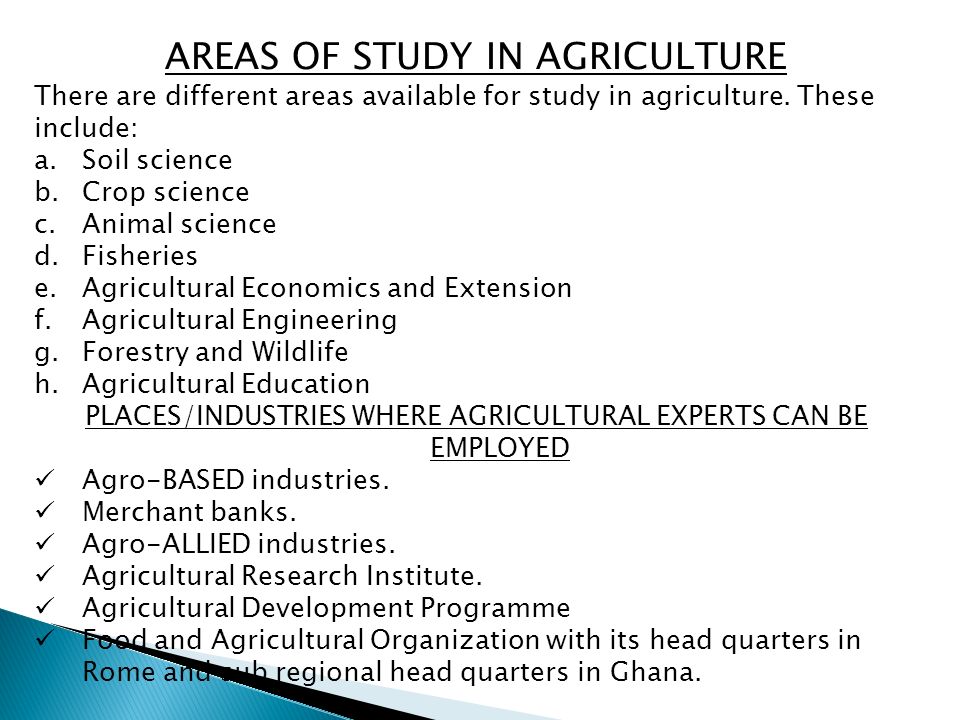
(1) Farming: private farmers establish and run their own farms to earn (money) a living. They can go into:
i. Poultry production
ii. Fishery
iii. Apiculture
iv. Cattle, sheep and goat production
v. Rabbitry
vi. Pig production
vii. Horticulture
viii. Crop production

(2) Buying and selling farm produce
Employment opportunities exist for people in buying and selling of agricultural products. They buy in bulk from the producers and sell in small quantities to consumers or retailers. Examples of crops are: yams, tomatoes, palm oil, oranges, vegetables, etc.
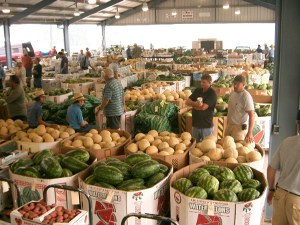
(3) Processing of agricultural produce
In some localities, small industries have been established for processing of agricultural products. Money is charged by the owner of the industry for processing products. Examples are:
i. Processing of cassava into garri.
ii. Processing of oil palm into palm oil.
iii. Milling of rice.
iv. Processing of groundnut into cake and oil.
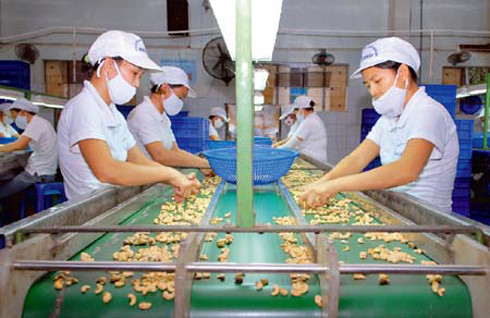
EVALUATION
1. Define the term ''employment''.
2. Give two examples of self-employment in agriculture.
LESSON 6
PAID EMPLOYMENT
The art of getting money through the use of one’s skills to work for another person, organization or government.
Examples of paid employment in agriculture are:
(a) Government ministries or establishments. Eg Ministries of Agriculture, Federal Prisons Service, etc.
(b) Agro-based industries. Eg Chemical industries, feeds industries, fertilizer industries, Textile industries, etc.
(c) Educational institutions Eg universities, Polytechnics. Colleges of Education, secondary schools, etc.
(d) Banks - All commercial banks.
(e) Research Institutes
Eg
Cocoa Research of Nigeria (CRIN),
National Cereal Research Institute (NCRI),
International Institute for Tropical Agriculture (IITA),
National Veterinary Research Institute (NVRI)
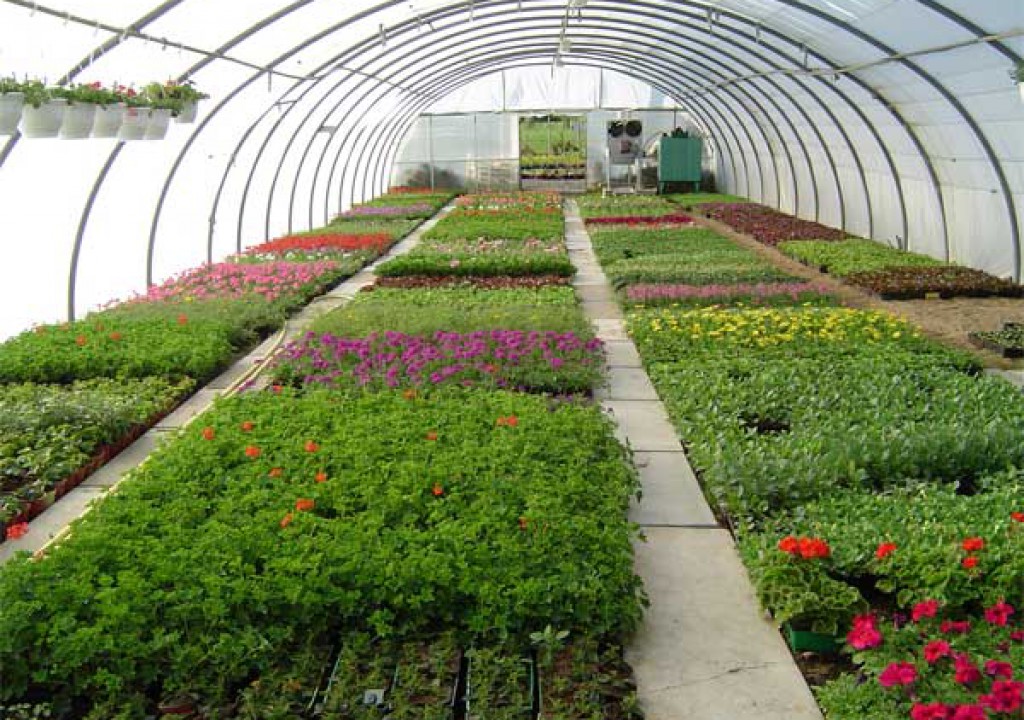
Employment Opportunities for Senior Secondary and Post Secondary School leavers.
1. School Certificate certificate holders who credited agricultural science could be offered jobs in the State or Federal Ministries of Agriculture as Assistant Agricultural superintendent in Training.
2. Secondary school leavers with at least four credits at 'O' level are also offered admission to study for the Ordinary National Diploma and Higher National Diploma courses in Agriculture Science and related fields. Such courses take duration of five years. The first two years for OND, one year field work; while the last two years are for the HOD.
The OND holders fits into the Assistant Agricultural Superintendent or Assistant Technical Officer position, while the HOD holder gets on as Higher Agricultural Superintendent or Higher Technical Officer.
Employment opportunities for university graduates
School certificate holder with five credits at 'O' level in Chemistry, Biology, Agricultural Science, Mathematics and at least, a pass in Physics are offered courses in Agricultural related fields in various universities in Nigeria, such courses last for five years, and leads to the award of a Bachelors Degree in the field. Agricultural Education courses last for four years, leading to B.Sc (Ed.) award.
Some courses of study in faculty of Agriculture and Education in Nigerian universities are:
a. Soil Science
b. Crop Science (Agronomy)
c. Animal Science
d. Agricultural Economics
e. agricultural Extension
f. Agricultural Engineering
g. Forestry
h. Fisheries
f. Agricultural Education
g. Veterinary medicine
h. Horticulture
Agricultural science graduates can start a career in:
1. Ministry of Agriculture as Agricultural Officers.
2. In Research Institutes as Research Officers.
3. In the state Education system as Teachers.
4. In universities and other tertiary institutions as graduate or research assistants.
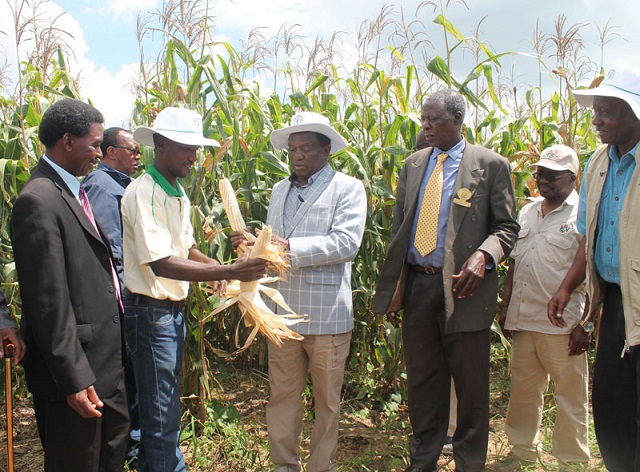
EVALUATION
1. List four examples of paid employment opportunities in agriculture.
2. List five courses of study available in Nigerian universities.
Objective Test:
1. Employment is also called ------
A. job B. career C. paid work D. all of the above
2. Agricultural school leavers in Nigeria are employed in the following establishments except
A. banks B. industry C. ministry D. military
3. Which of the following is a self employed position for agricultural school leaver in Nigeria?
A. Agricultural officer B. Producer retailer C. Research officer D. School teacher
4. Which of the following is not part of the agro-allied industries?
A. oil mill B. saw mills C. cotton and wool ginneries D. oil exploration firms
5. A person who practices agriculture is called a ------
A. apiculturist B. doctor C. horticulturist D. farmer
Essay Test:
1. List five Agricultural Science courses of study available in Nigerian universities.
2. Mention 2 employment positions available to Agricultural Science graduates.
Reference Texts
1. New Intensive Agricultural Science for Junior Secondary Schools by E.U Okaro.
2. Spectrum Agricultural Science for Junior Secondary Schools by B.A. Adelekan et'al.
3. Essentials of Agricultural Science for Junior Secondary Schools /Colleges in West Africa by Earnest Chukwudi Anie.
TOPIC: EMPLOYMENT OPPORTUNITIES IN AGRICULTURE
CONTENT: 1. Self-employment
2. Paid employment
EMPLOYMENT OPPORTUNITIES IN AGRICULTURE
Employment is the paid work, job or occupation which somebody does for a living.
Any such employment in which somebody gets profitably involved for a reasonable length of time, especially during his or her adult life is called a career.
The employment opportunities in agriculture are grouped into two. They are:
1. Self-employment
2. Paid employment
Self employment
This is the method of getting money through the use of one’s skills without working for another person, organization or government.
Examples of self employment in agriculture are:
(a)Farming
(b) Buying and selling farm produce
(c) Processing of farm produce

(1) Farming: private farmers establish and run their own farms to earn (money) a living. They can go into:
i. Poultry production
ii. Fishery
iii. Apiculture
iv. Cattle, sheep and goat production
v. Rabbitry
vi. Pig production
vii. Horticulture
viii. Crop production

(2) Buying and selling farm produce
Employment opportunities exist for people in buying and selling of agricultural products. They buy in bulk from the producers and sell in small quantities to consumers or retailers. Examples of crops are: yams, tomatoes, palm oil, oranges, vegetables, etc.

(3) Processing of agricultural produce
In some localities, small industries have been established for processing of agricultural products. Money is charged by the owner of the industry for processing products. Examples are:
i. Processing of cassava into garri.
ii. Processing of oil palm into palm oil.
iii. Milling of rice.
iv. Processing of groundnut into cake and oil.

EVALUATION
1. Define the term ''employment''.
2. Give two examples of self-employment in agriculture.
LESSON 6
PAID EMPLOYMENT
The art of getting money through the use of one’s skills to work for another person, organization or government.
Examples of paid employment in agriculture are:
(a) Government ministries or establishments. Eg Ministries of Agriculture, Federal Prisons Service, etc.
(b) Agro-based industries. Eg Chemical industries, feeds industries, fertilizer industries, Textile industries, etc.
(c) Educational institutions Eg universities, Polytechnics. Colleges of Education, secondary schools, etc.
(d) Banks - All commercial banks.
(e) Research Institutes
Eg
Cocoa Research of Nigeria (CRIN),
National Cereal Research Institute (NCRI),
International Institute for Tropical Agriculture (IITA),
National Veterinary Research Institute (NVRI)

Employment Opportunities for Senior Secondary and Post Secondary School leavers.
1. School Certificate certificate holders who credited agricultural science could be offered jobs in the State or Federal Ministries of Agriculture as Assistant Agricultural superintendent in Training.
2. Secondary school leavers with at least four credits at 'O' level are also offered admission to study for the Ordinary National Diploma and Higher National Diploma courses in Agriculture Science and related fields. Such courses take duration of five years. The first two years for OND, one year field work; while the last two years are for the HOD.
The OND holders fits into the Assistant Agricultural Superintendent or Assistant Technical Officer position, while the HOD holder gets on as Higher Agricultural Superintendent or Higher Technical Officer.
Employment opportunities for university graduates
School certificate holder with five credits at 'O' level in Chemistry, Biology, Agricultural Science, Mathematics and at least, a pass in Physics are offered courses in Agricultural related fields in various universities in Nigeria, such courses last for five years, and leads to the award of a Bachelors Degree in the field. Agricultural Education courses last for four years, leading to B.Sc (Ed.) award.
Some courses of study in faculty of Agriculture and Education in Nigerian universities are:
a. Soil Science
b. Crop Science (Agronomy)
c. Animal Science
d. Agricultural Economics
e. agricultural Extension
f. Agricultural Engineering
g. Forestry
h. Fisheries
f. Agricultural Education
g. Veterinary medicine
h. Horticulture
Agricultural science graduates can start a career in:
1. Ministry of Agriculture as Agricultural Officers.
2. In Research Institutes as Research Officers.
3. In the state Education system as Teachers.
4. In universities and other tertiary institutions as graduate or research assistants.

EVALUATION
1. List four examples of paid employment opportunities in agriculture.
2. List five courses of study available in Nigerian universities.
Objective Test:
1. Employment is also called ------
A. job B. career C. paid work D. all of the above
2. Agricultural school leavers in Nigeria are employed in the following establishments except
A. banks B. industry C. ministry D. military
3. Which of the following is a self employed position for agricultural school leaver in Nigeria?
A. Agricultural officer B. Producer retailer C. Research officer D. School teacher
4. Which of the following is not part of the agro-allied industries?
A. oil mill B. saw mills C. cotton and wool ginneries D. oil exploration firms
5. A person who practices agriculture is called a ------
A. apiculturist B. doctor C. horticulturist D. farmer
Essay Test:
1. List five Agricultural Science courses of study available in Nigerian universities.
2. Mention 2 employment positions available to Agricultural Science graduates.
Reference Texts
1. New Intensive Agricultural Science for Junior Secondary Schools by E.U Okaro.
2. Spectrum Agricultural Science for Junior Secondary Schools by B.A. Adelekan et'al.
3. Essentials of Agricultural Science for Junior Secondary Schools /Colleges in West Africa by Earnest Chukwudi Anie.
WEEK 5
LESSON 7
TOPIC: Early Development of World Agriculture
CONTENTS:
1. Periods of Agricultural Development
- Introduction
- The Paleolithic era
- The Mesolithic era
- The Neolithic era
2. The Agrarian (Agric) Revolution.
PERIODS OF AGRICULTURAL DEVELOPMENT
The history of agriculture is as old as man. The early man moved from place to place to gather food and clothing from wild plants and the skin of animals. The early men began to catch and tame some of the animals. They also learned how to plant and cultivate some crops such as rice, barley and wheat. This was the beginning of growing crops and domestication of animals.
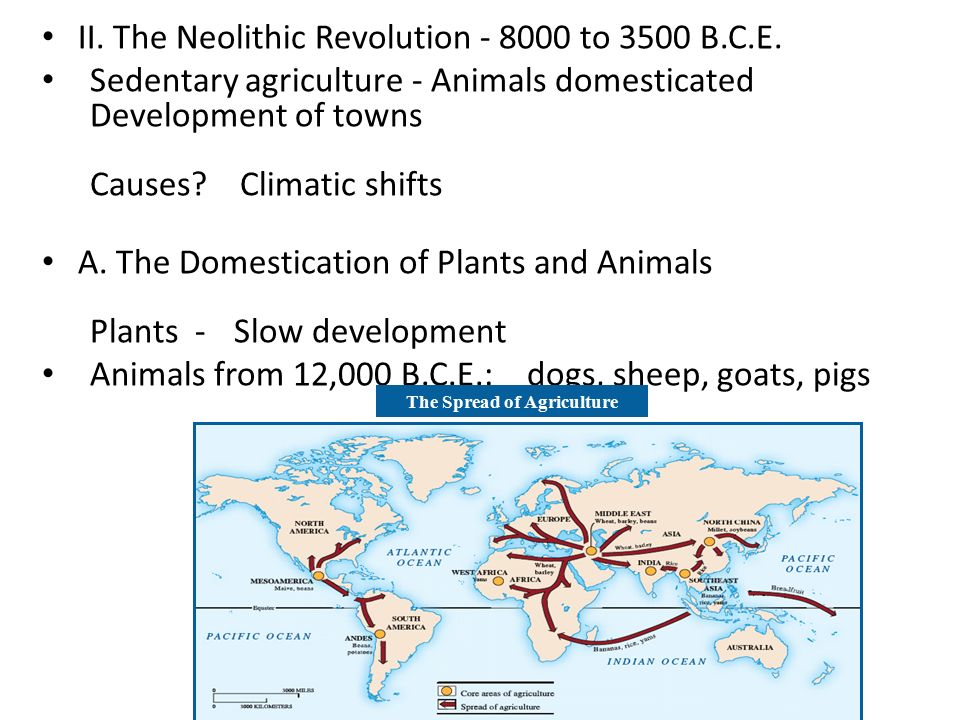
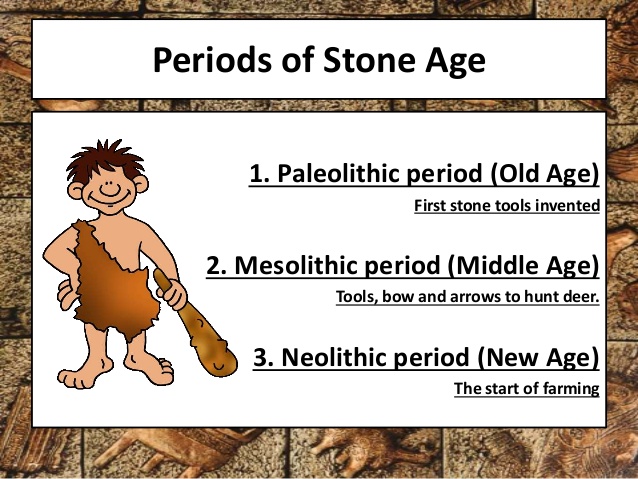
Early development of world agriculture is divided into three eras (periods):
1.Paleolithic Era or Old Stone Age (9000-8000BC)
2 Mesolithic Era (8000-7000 BC
3 Neolithic Era or New Stone Age (7000-6500 BC) .
1. Paleolithic Era or Old Stone Age (9000-8000BC)
This era is also known as Old Stone Age .This is the period when humans were cave dwellers and food gatherers for almost five million years , the food they ate were vegetables, tasty insect larvae and small reptiles.
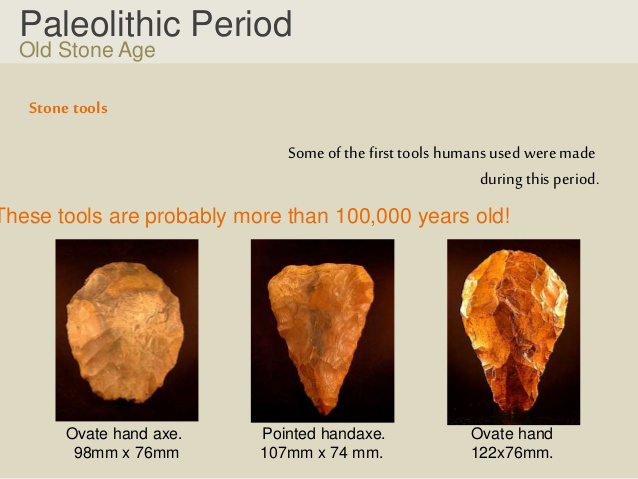

2. The Mesolithic Era (8000-7000 BC )
This period is known as middle stone age .It was the period between the Paleolithic Period and Neolithic Period, humans were still gathering food, living by hunting, fishing, and collecting fruits, berries, nuts and other edible plants .The Mesolithic hunter achieved a greater efficiency than the Paleolithic and was able to exploit a wider range of animal and vegetable food sources.
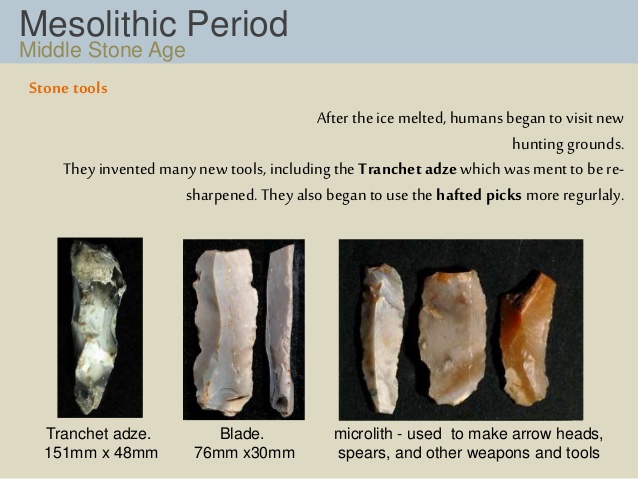
3. The Neolithic Era (7000-6500BC)
The Neolithic Era is also known as New Stone Age and characterized by the following features:
i) Settled village life.
ii) The art of processing by grinding.
iii) Development of elementary agriculture.
Historically, agriculture originated Near East, as men were hunting for the animals the women were gathering fruits. Some animals were kept and later gave birth to young ones, also some of the fruits that were thrown away later germinated and bore fruits, through that women learnt that fruits and other crops could be cultivated. People commonly believed that the early development of agriculture was incidental and not deliberate.
Early men began to observe that plants grew better when the ground were broken .They were using crude digging sticks to break the ground for cultivation of crops. Wooden plough was later developed (a crooked stick that one man held in position while one or two other men dragged through the soil). Later, horses, oxen, and other work animals were trained to pull ploughs. Early men and women who were practicing settled agriculture developed villages. The early people that lived in settled village Near East cultivated crops such as wheat, barley, and pears.
Agriculture stated in many places such as Palestine Switzerland, Great Britain, Syria, the Mediterranean , Iraq ,Iran ,Arabia, Kenya ,Tibet and Egypt before Nigeria and Ghana.
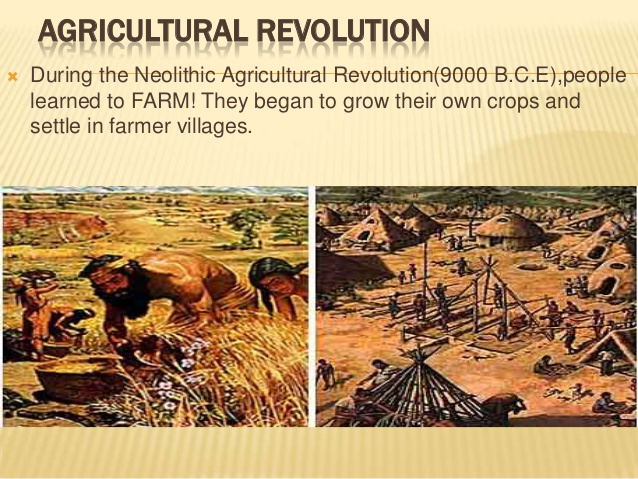
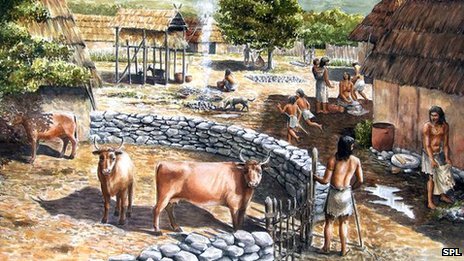
EVALUATION:
1 Mention the characteristics of new Stone Age.
2. Mention three divisions of early development of world agriculture.
LESSON 8
AGRICULTURAL REVOLUTION (1700-1986) (Agrarian Revolution)
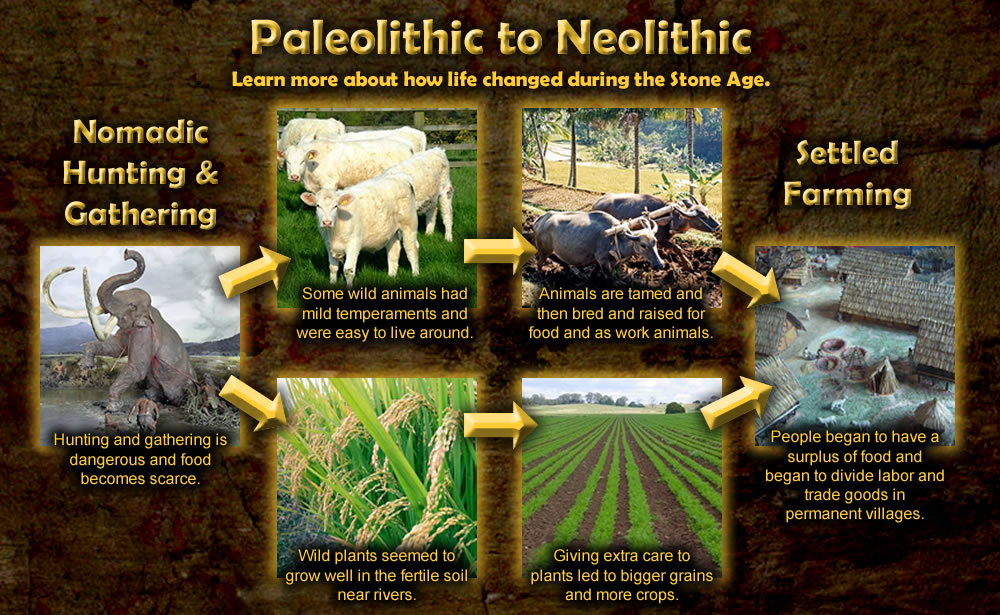
Agricultural revolution started in the 1700s and 1800s in Europe, particularly in Britain .This is when humans gradually developed mechanized agriculture.
People who played major roles in agricultural revolution:
(a).Jethro Tull: He invented the horse-drawn cultivator for tilling the soil and drill for planting seeds.
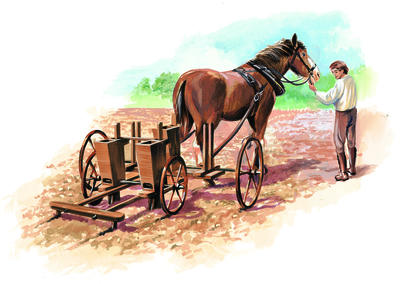
b).Charles Townshend: He was the first person to introduce turnips and other root crops and how to cultivate them in a better way by rotating them in the farm.
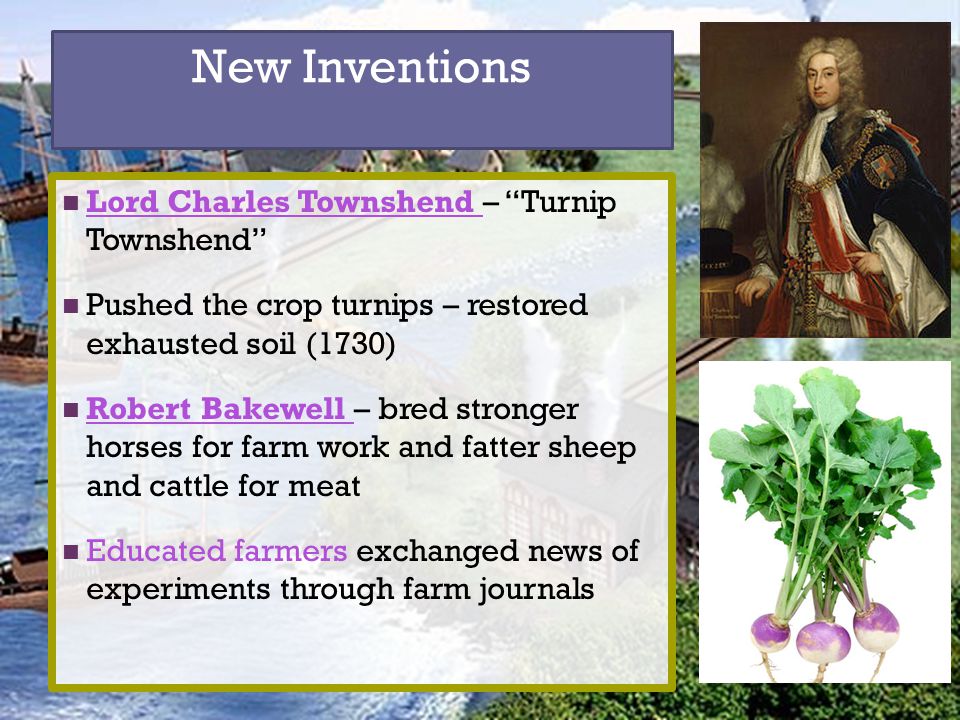
C).Cyrus Hall McCormick: He invented the horse-drawn reaper machine in 1931. It was an improvement over the horse drawn plough invented by Tull.The McCormick machines was faster than the horse drawn cultivator.
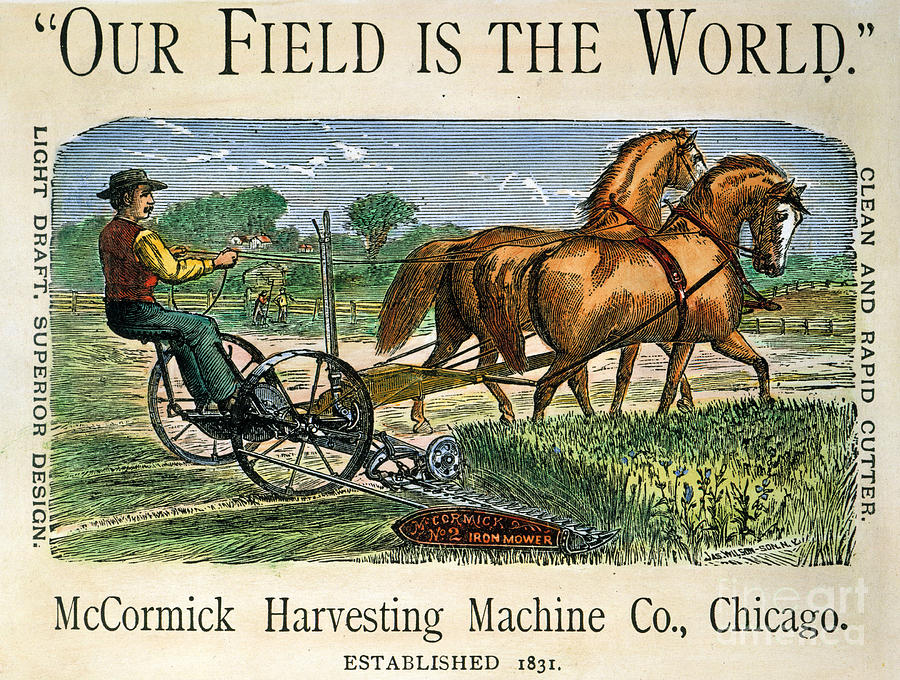
D}.Robert Bakewell: He was an animal breeder who carried out pioneer work genetic. He was one of the first animal breeders to breed both sheep and cattle for meat. Through his work, the world learnt about cross-breeding of animals of the same species.
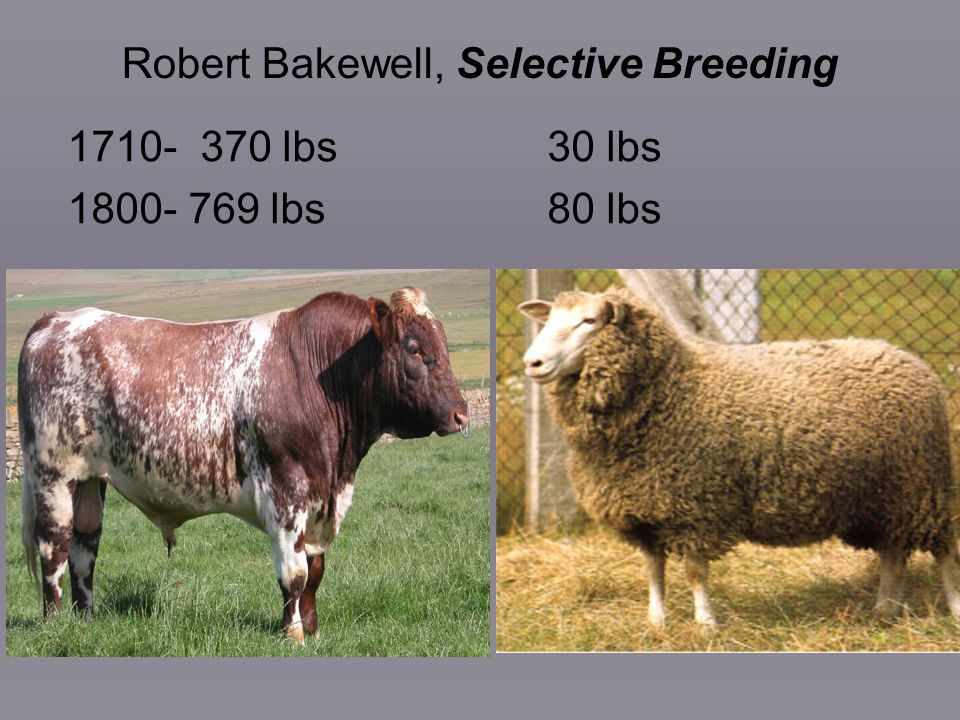
American businessmen invented meat-peaking plants to process farm products. After World War I between 1914 and 1918, American farmers began to use tractors and tractor-drawn machines for cultivation of crops, through these machines, American farmers achieved high agricultural production.
The use of electricity began as a source of power between 1930-1940.There are various machines such as tractor-pulled/drawn machines which can reap (harvest), thresh grains in one single operation, spread fertilizer and harvest cotton, rice, corn.etc.
Farm inputs such as herbicides, fertilizers and insecticides are used extensively in most parts of the world to increase crop yields by reducing losses due to crop and livestock pests, diseases and weeds. As a result of all these advances in agriculture, it is easy to cultivate large areas of land to produce enough food for the rapidly increasing world population.
EVALUATION:
Mention two people and the roles they played in agricultural revolution.
ASSIGNMENT: Mention five importance of school farm.
Objective Test:
1 The Mesolithic Era period was from…………A .6000-800BC B. 8000-7000BC C. 1996-2007AD D. 8000-8000BC E. 2000-2009AD
2 The Paleolithic Era was also called ………..A. The Old Stone Age B. The New Age C. The Past Age D. The New Stone Age E. The Coming Age .
3. The Jethro Tull invented the horse-drawn cultivator for…………
A. cutting down trees B. Tilling the soil C. carrying goats D. Harvesting maize E. milking cow.
4 Which machines did American farmers use for growing crops after the first World War between 1914- 1918? A. Combined harvester B. Boom sprayers C. Tractor and tractor drawn machines D. Scissors E. Seed planters.
5. The early humans who practiced settled agriculture developed………..
A. cities B. villages’ C. aero plane D. boats E. television sets
TOPIC: Early Development of World Agriculture
CONTENTS:
1. Periods of Agricultural Development
- Introduction
- The Paleolithic era
- The Mesolithic era
- The Neolithic era
2. The Agrarian (Agric) Revolution.
PERIODS OF AGRICULTURAL DEVELOPMENT
The history of agriculture is as old as man. The early man moved from place to place to gather food and clothing from wild plants and the skin of animals. The early men began to catch and tame some of the animals. They also learned how to plant and cultivate some crops such as rice, barley and wheat. This was the beginning of growing crops and domestication of animals.


Early development of world agriculture is divided into three eras (periods):
1.Paleolithic Era or Old Stone Age (9000-8000BC)
2 Mesolithic Era (8000-7000 BC
3 Neolithic Era or New Stone Age (7000-6500 BC) .
1. Paleolithic Era or Old Stone Age (9000-8000BC)
This era is also known as Old Stone Age .This is the period when humans were cave dwellers and food gatherers for almost five million years , the food they ate were vegetables, tasty insect larvae and small reptiles.


2. The Mesolithic Era (8000-7000 BC )
This period is known as middle stone age .It was the period between the Paleolithic Period and Neolithic Period, humans were still gathering food, living by hunting, fishing, and collecting fruits, berries, nuts and other edible plants .The Mesolithic hunter achieved a greater efficiency than the Paleolithic and was able to exploit a wider range of animal and vegetable food sources.

3. The Neolithic Era (7000-6500BC)
The Neolithic Era is also known as New Stone Age and characterized by the following features:
i) Settled village life.
ii) The art of processing by grinding.
iii) Development of elementary agriculture.
Historically, agriculture originated Near East, as men were hunting for the animals the women were gathering fruits. Some animals were kept and later gave birth to young ones, also some of the fruits that were thrown away later germinated and bore fruits, through that women learnt that fruits and other crops could be cultivated. People commonly believed that the early development of agriculture was incidental and not deliberate.
Early men began to observe that plants grew better when the ground were broken .They were using crude digging sticks to break the ground for cultivation of crops. Wooden plough was later developed (a crooked stick that one man held in position while one or two other men dragged through the soil). Later, horses, oxen, and other work animals were trained to pull ploughs. Early men and women who were practicing settled agriculture developed villages. The early people that lived in settled village Near East cultivated crops such as wheat, barley, and pears.
Agriculture stated in many places such as Palestine Switzerland, Great Britain, Syria, the Mediterranean , Iraq ,Iran ,Arabia, Kenya ,Tibet and Egypt before Nigeria and Ghana.


EVALUATION:
1 Mention the characteristics of new Stone Age.
2. Mention three divisions of early development of world agriculture.
LESSON 8
AGRICULTURAL REVOLUTION (1700-1986) (Agrarian Revolution)

Agricultural revolution started in the 1700s and 1800s in Europe, particularly in Britain .This is when humans gradually developed mechanized agriculture.
People who played major roles in agricultural revolution:
(a).Jethro Tull: He invented the horse-drawn cultivator for tilling the soil and drill for planting seeds.

b).Charles Townshend: He was the first person to introduce turnips and other root crops and how to cultivate them in a better way by rotating them in the farm.

C).Cyrus Hall McCormick: He invented the horse-drawn reaper machine in 1931. It was an improvement over the horse drawn plough invented by Tull.The McCormick machines was faster than the horse drawn cultivator.

D}.Robert Bakewell: He was an animal breeder who carried out pioneer work genetic. He was one of the first animal breeders to breed both sheep and cattle for meat. Through his work, the world learnt about cross-breeding of animals of the same species.

American businessmen invented meat-peaking plants to process farm products. After World War I between 1914 and 1918, American farmers began to use tractors and tractor-drawn machines for cultivation of crops, through these machines, American farmers achieved high agricultural production.
The use of electricity began as a source of power between 1930-1940.There are various machines such as tractor-pulled/drawn machines which can reap (harvest), thresh grains in one single operation, spread fertilizer and harvest cotton, rice, corn.etc.
Farm inputs such as herbicides, fertilizers and insecticides are used extensively in most parts of the world to increase crop yields by reducing losses due to crop and livestock pests, diseases and weeds. As a result of all these advances in agriculture, it is easy to cultivate large areas of land to produce enough food for the rapidly increasing world population.
EVALUATION:
Mention two people and the roles they played in agricultural revolution.
ASSIGNMENT: Mention five importance of school farm.
Objective Test:
1 The Mesolithic Era period was from…………A .6000-800BC B. 8000-7000BC C. 1996-2007AD D. 8000-8000BC E. 2000-2009AD
2 The Paleolithic Era was also called ………..A. The Old Stone Age B. The New Age C. The Past Age D. The New Stone Age E. The Coming Age .
3. The Jethro Tull invented the horse-drawn cultivator for…………
A. cutting down trees B. Tilling the soil C. carrying goats D. Harvesting maize E. milking cow.
4 Which machines did American farmers use for growing crops after the first World War between 1914- 1918? A. Combined harvester B. Boom sprayers C. Tractor and tractor drawn machines D. Scissors E. Seed planters.
5. The early humans who practiced settled agriculture developed………..
A. cities B. villages’ C. aero plane D. boats E. television sets
WEEK 6
LESSON 9
TOPIC: School Farm
CONTENTS: 1. Meaning and Importance of School farm: (school, students, community)
2. Principles of sitting school farm; Problems of sitting a school farm
MEANING AND IMPORTANCE OF SCHOOL FARM
MEANING OF SCHOOL FARM
School farm is an area of land for growing crops or raising farm animals. School farm is a place where students of agriculture acquire practical skills and knowledge in crop or animal production. School farm is also known as land laboratory. It is a place where students learn agriculture by doing it themselves.

Importance of school farm
1 Source of income to the school.
2 It is a place where teaching and learning takes place
3 It serves as a source of food for the school e.g boarding schools.
4 It serves as centre of attraction to school visitors.
5 It serves as demonstration centre for the students and teacher.
6 It helps the students to learn fast.
Principles of sitting school farm
1. Availability of land.
2 Nearness to the school.
3. Nature of the soil.
4 Topography (Slope of the land).
5 Accessibility (Good access road).
6 Water supplies (Availability of water).
Problems of sitting school farm
A) Unavailability of land (Land scarcity).
b) Improper maintenance of the farm.
c) Poor attitude of students toward farming.
d) Climatic factors e.g rain, drought etc.
e) School policy.
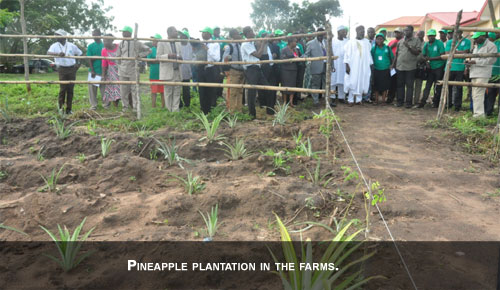
EVALUATION:
1. Define school farm.
2. List five importance of sitting school farm
3. Mention five principles of sitting school farm.
4. What are the problems of sitting school farm?
ASSIGNMENT:
Objective Test:
1 _________ is an area of land for growing crops and or raising farm animals
A. School farm b. Class room C.Dining hall D. sport complex E. Bath room
2. The following are principles for sitting school farm EXCEPT
A. Availability of land.
B. Nearness to the school.
C. Nature of the soil.
D. Topography (Slope of the land).
E. Availability of students.
3. School farm must be closed to the ___ A. toilet B. School C. Stadium D. garage E. office.
4. Another name for school farm is ________A. Land laboratory B. Library C .Kitchen D. Garage E. Fellowship.
5. ____ and ____ take place in the school farm. A. teaching, learning B. buying, selling C. Singing, talking D. eating, drinking E. running, jumping.
Essay Test:
Write short note on the following:
I. Farm record ii Profit and loss account iii Consumption Record iv Inventory v Farm diary.
REFERENCE TEXT:
1. Prescribed Agricultural Science for JSS, book 2 by Omoruyi S.A. et al.
2. Junior Secondary Agriculture for Senior Schools, book 3 by Anthony Youdeowei et al.
TOPIC: School Farm
CONTENTS: 1. Meaning and Importance of School farm: (school, students, community)
2. Principles of sitting school farm; Problems of sitting a school farm
MEANING AND IMPORTANCE OF SCHOOL FARM
MEANING OF SCHOOL FARM
School farm is an area of land for growing crops or raising farm animals. School farm is a place where students of agriculture acquire practical skills and knowledge in crop or animal production. School farm is also known as land laboratory. It is a place where students learn agriculture by doing it themselves.

Importance of school farm
1 Source of income to the school.
2 It is a place where teaching and learning takes place
3 It serves as a source of food for the school e.g boarding schools.
4 It serves as centre of attraction to school visitors.
5 It serves as demonstration centre for the students and teacher.
6 It helps the students to learn fast.
Principles of sitting school farm
1. Availability of land.
2 Nearness to the school.
3. Nature of the soil.
4 Topography (Slope of the land).
5 Accessibility (Good access road).
6 Water supplies (Availability of water).
Problems of sitting school farm
A) Unavailability of land (Land scarcity).
b) Improper maintenance of the farm.
c) Poor attitude of students toward farming.
d) Climatic factors e.g rain, drought etc.
e) School policy.

EVALUATION:
1. Define school farm.
2. List five importance of sitting school farm
3. Mention five principles of sitting school farm.
4. What are the problems of sitting school farm?
ASSIGNMENT:
Objective Test:
1 _________ is an area of land for growing crops and or raising farm animals
A. School farm b. Class room C.Dining hall D. sport complex E. Bath room
2. The following are principles for sitting school farm EXCEPT
A. Availability of land.
B. Nearness to the school.
C. Nature of the soil.
D. Topography (Slope of the land).
E. Availability of students.
3. School farm must be closed to the ___ A. toilet B. School C. Stadium D. garage E. office.
4. Another name for school farm is ________A. Land laboratory B. Library C .Kitchen D. Garage E. Fellowship.
5. ____ and ____ take place in the school farm. A. teaching, learning B. buying, selling C. Singing, talking D. eating, drinking E. running, jumping.
Essay Test:
Write short note on the following:
I. Farm record ii Profit and loss account iii Consumption Record iv Inventory v Farm diary.
REFERENCE TEXT:
1. Prescribed Agricultural Science for JSS, book 2 by Omoruyi S.A. et al.
2. Junior Secondary Agriculture for Senior Schools, book 3 by Anthony Youdeowei et al.
WEEK 7
LESSON 10
TOPIC: Farm records:
CONTENTS: 1. Meaning of Farm records and Importance of farm records
2. Types of farm records
MEANING OF FARM RECORDS AND IMPORTANCE OF FARM RECORDS
MEANING OF FARM RECORDS
Farm records are written documents showing major activities going on in the farming business. Or Farm records are records of all the operations that are undertaken in the farm throughout the year.
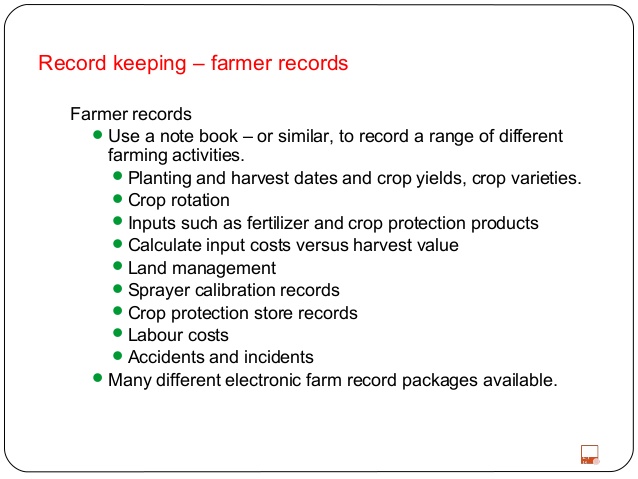
IMPORTANCE OF FARM RECORDS
1 It shows the financial position of the farm
2 It helps the farmer to monitor the changes in prices of produce bought or sold.
3 It enables the farmer to know whether he is running the farm at profit or loss.
4 It enables the farmer to detect fraudulent practices on the farm.
5 To determine the actual worth of the farm.
6 For taking management decision.
7 For procurement of loans.
8 It makes it possible to determine the annual tax of the farm.
9 It can be used for comparing the management efficiency over time.
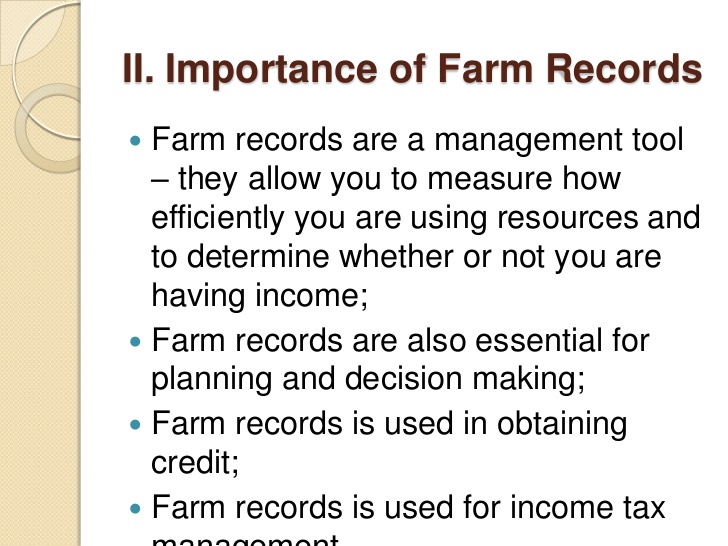
EVALUATION
1. Define farm record.
2. Mention the importance of school farm.
LESSON 11
TYPES OF FARM RECORDS
i .Farm diary.
ii .Farm inventory.
iii .Production record
iv. Input record.
v. Consumption record.
vi. Sale record
vii. Profit and loss accounts
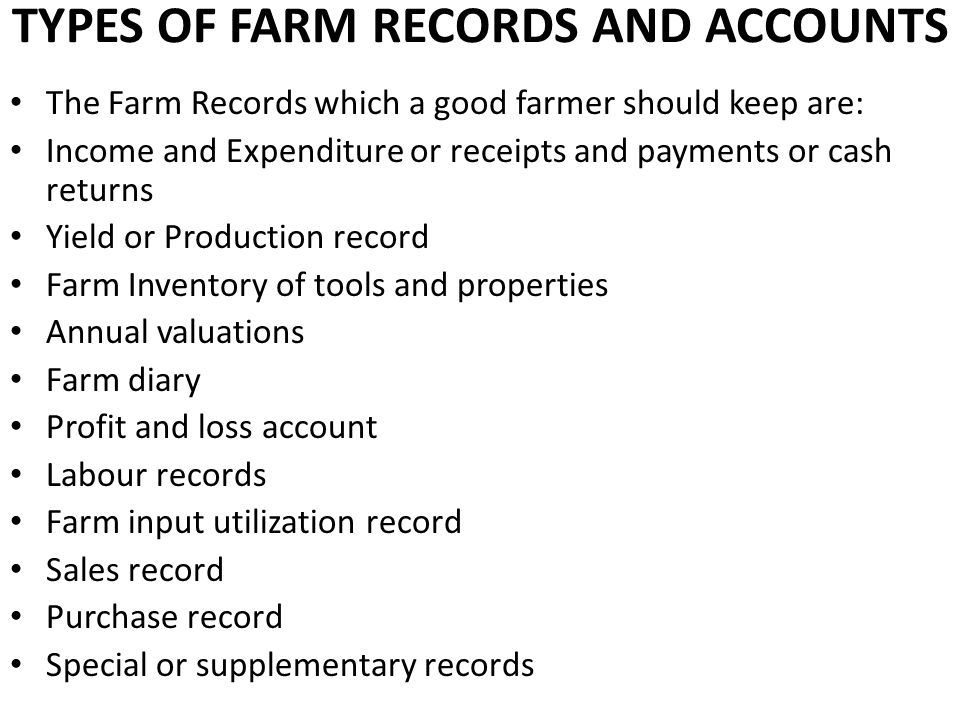
Farm Diary: A farm diary is a record of the daily activities carried out on the farm. A typical farm record shows type of work done, date, the number of workers, time spent and others.
The farm Inventory: This is the list of all the assets or materials on the farm e g farm building and structures, machinery, livestock, farm input, produce stored, growing crops, land etc.
Production records: These are records that show all the things produced on the farm. Such items include crops, livestock and livestock products.
Input record: This is a record that shows all inputs purchased and used for production in the farm over a period of time .Such inputs are seeds, fertilizer, seedlings, chemicals, animal feeds, day old chicks, drugs etc.
Sales record: This shows all sales made by the farmer. Farmer realizes some income when he sells his produce. When income from sales exceeds expenses, the farmer is said to make profit and vice versa.
Consumption record: This is the record of the farm products consumed by the farmer and his family as well as farm products given out as gifts .The cost of the items consumed or given away must be made at current market price.
Profit and Loss account: This is the record of the sales (income) and the expenditure (expenses) made at the end of the year. It shows the success or failure of the farm. It also produces account for various managerial purposes. It is used to take certain decision on the performance of the farm.
EVALUATION:
1 Explain the following farm records:
2. Consumption record. Ii) Farm diary.
ASSIGNMENT:
Objective Test:
1_____ is the record of the farm products consumed by the farmer and his family as well as farm products given out as gifts.
A. Farm diary B. Consumption record C. Inventory record D. Profit and loss account E. Sales record.
2. ________ are written documents showing major activities going on in the farming business.
A. Farm diary B. Sales record C. Profit and loss account D. Farm records E. Input records.
3. The following are farm records EXCEPT A. Cash receipt B. Farm diary C. Sales record D. Inventory record. E. Input record
4. _________ is a record of the daily activities carried out on the farm.
A. Production record B. Sales record C. Input record D. Farm diary E. Inventory record.
5.The following are the importance of farm records EXCEPT.
A. It helps us to know the number of students in agricultural class.
B. 4 It enables the farmer to detect fraudulent practices on the farm.
C. To determine the actual worth of the farm.
D. For taking management decision.
E. For procurement of loans.
REFERENCE TEXT:1 Basic of Agricultural Science, Basic 9,by Aremu et al.
2. Prescribed Agricultural Science for JSS, book 2 by Omoruyi S.A et al.
TOPIC: Farm records:
CONTENTS: 1. Meaning of Farm records and Importance of farm records
2. Types of farm records
MEANING OF FARM RECORDS AND IMPORTANCE OF FARM RECORDS
MEANING OF FARM RECORDS
Farm records are written documents showing major activities going on in the farming business. Or Farm records are records of all the operations that are undertaken in the farm throughout the year.

IMPORTANCE OF FARM RECORDS
1 It shows the financial position of the farm
2 It helps the farmer to monitor the changes in prices of produce bought or sold.
3 It enables the farmer to know whether he is running the farm at profit or loss.
4 It enables the farmer to detect fraudulent practices on the farm.
5 To determine the actual worth of the farm.
6 For taking management decision.
7 For procurement of loans.
8 It makes it possible to determine the annual tax of the farm.
9 It can be used for comparing the management efficiency over time.

EVALUATION
1. Define farm record.
2. Mention the importance of school farm.
LESSON 11
TYPES OF FARM RECORDS
i .Farm diary.
ii .Farm inventory.
iii .Production record
iv. Input record.
v. Consumption record.
vi. Sale record
vii. Profit and loss accounts

Farm Diary: A farm diary is a record of the daily activities carried out on the farm. A typical farm record shows type of work done, date, the number of workers, time spent and others.
The farm Inventory: This is the list of all the assets or materials on the farm e g farm building and structures, machinery, livestock, farm input, produce stored, growing crops, land etc.
Production records: These are records that show all the things produced on the farm. Such items include crops, livestock and livestock products.
Input record: This is a record that shows all inputs purchased and used for production in the farm over a period of time .Such inputs are seeds, fertilizer, seedlings, chemicals, animal feeds, day old chicks, drugs etc.
Sales record: This shows all sales made by the farmer. Farmer realizes some income when he sells his produce. When income from sales exceeds expenses, the farmer is said to make profit and vice versa.
Consumption record: This is the record of the farm products consumed by the farmer and his family as well as farm products given out as gifts .The cost of the items consumed or given away must be made at current market price.
Profit and Loss account: This is the record of the sales (income) and the expenditure (expenses) made at the end of the year. It shows the success or failure of the farm. It also produces account for various managerial purposes. It is used to take certain decision on the performance of the farm.
EVALUATION:
1 Explain the following farm records:
2. Consumption record. Ii) Farm diary.
ASSIGNMENT:
Objective Test:
1_____ is the record of the farm products consumed by the farmer and his family as well as farm products given out as gifts.
A. Farm diary B. Consumption record C. Inventory record D. Profit and loss account E. Sales record.
2. ________ are written documents showing major activities going on in the farming business.
A. Farm diary B. Sales record C. Profit and loss account D. Farm records E. Input records.
3. The following are farm records EXCEPT A. Cash receipt B. Farm diary C. Sales record D. Inventory record. E. Input record
4. _________ is a record of the daily activities carried out on the farm.
A. Production record B. Sales record C. Input record D. Farm diary E. Inventory record.
5.The following are the importance of farm records EXCEPT.
A. It helps us to know the number of students in agricultural class.
B. 4 It enables the farmer to detect fraudulent practices on the farm.
C. To determine the actual worth of the farm.
D. For taking management decision.
E. For procurement of loans.
REFERENCE TEXT:1 Basic of Agricultural Science, Basic 9,by Aremu et al.
2. Prescribed Agricultural Science for JSS, book 2 by Omoruyi S.A et al.
WEEK 8
LESSON 12
TOPIC: CURRENT ISSUES IN AFRICAN AGRICULTURE
CONTENTS: 1. Food crisis in Africa; Hunger and poverty in Africa;
2. Meeting the challenges of African food crisis:
- Hunger and poverty;
- New programmes in African Agriculture
THE FOOD CRISIS IN AFRICA
Factors affecting the ways by which farmers produce food in Africa
1 .Poor soil
2.Unfavorable weather conditions.
3.Pests and diseases.
4 .Poor storage facilities.
5 .Poor transportation systems.
6 .Poor marketing systems: Markets are not well developed.
7 .Inadequate loans and credit facilities.
8. Rebels activities and civil wars e. g civil wars in Somalia ,Sudan ,Sierra Leone Cote’ d Ivoire and Republic of Congo.

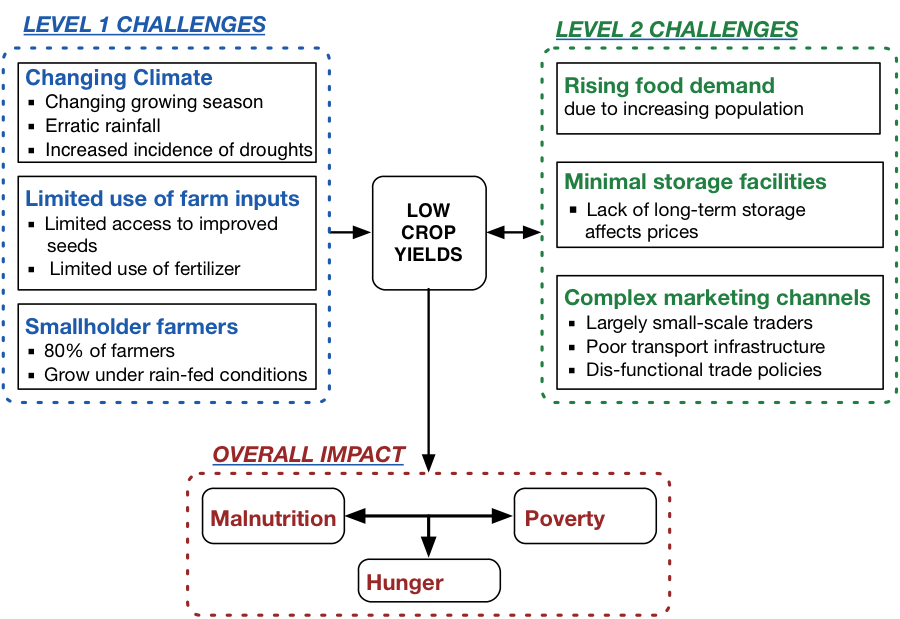
HUNGER AND POVERTY IN AFRICA
Africa is referred to as a rural continent .Over 70 percent of the labour in Africa engaged in Agricultural activities. This means that most Africans in the rural areas are farmers, but what they produce is not enough to feed all the people in Africa. Survey in 1997-1999 has shown that about 200 million people {28%) of the entire population of Africa are facing serious shortages of food and therefore they are hungry.
Many African governments spend a lot of money to import food from other countries. Also the governments of rich countries such as USA, England, Canada, France, Germany, and Australia help to supply food free to several chronically hungry African countries especially during emergencies such as drought, famine, floods and civil wars.
The major programmes for supplying free food to hungry countries are known as International Food Aid.

Many African countries receive a lot of food aid. The International Food Aid programme is coordinated by the World Food Programme (WFP).In the year 2000, WFP records shows that Africa received 2.8 million tones of international food aid. Also, south of Sahara desert imported 17 million tons of food to feed its people. Africa Heads of States held a world meeting in Johannesburg, South Africa in the year 2000.They signed a declaration called the Millennium Development Goals (MDGs).One of the goals unitedly agreed upon which concern agriculture, is that the number of hungry people in Africa must be reduced by half (50%) by the year 2015.

EVALUATION: 1. Mention factors affecting the ways by which farmers produce food in Africa.
LESSON 13
MEETING THE CHALLENGES OF AFRICAN FOOD CRISIS: HUNGER AND POVERTY;
NEW PROGRAMME IN AFRICAN AGRICULTURE.
Various programmes organized by African countries to improve food production and remove hunger and poverty include the following:
1 New Partnership for African Development (NEPAD)
2 National Poverty Reduction Strategies.
3 The Special Programme for Food Security: It is organized by Food and Agriculture Organization (FAO) of United Nations.
4 International Funds for Agricultural Development (IFAD)
5 Science, Information and Communication for Agriculture.
6 Nigeria’s programmes for reducing hunger and poverty e.g. National Economic Empowerment and Development Strategy (NEEDS)and States Economic Empowerment and Development Strategy (SEEDS)

CAUSES OF POVERTY
i] Over population.
ii] Unequal distribution of resources.
iii] Inability to meet high standard of living and cost of living.
iv) Environmental degradation.
v) Inadequate education and employment opportunity.
vi) Economic and demographic trend.
vii) Individual responsibility and welfare dependence.
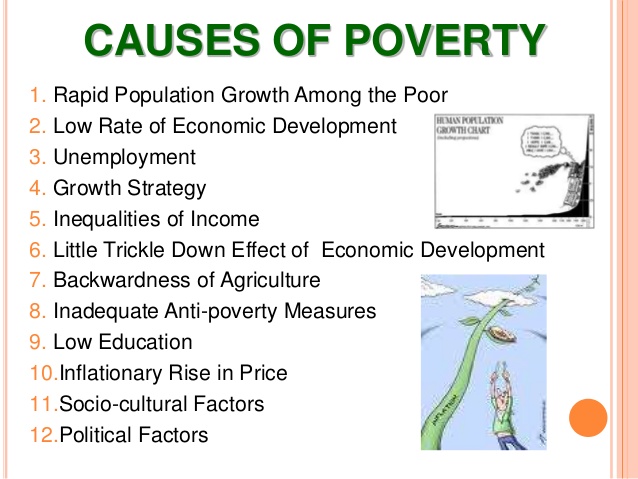
EFFECTS OF POVERTY
-Malnutrition and starvation
-Infectious diseases and exposure to
-Crime and violence
-Mental illness and drug dependence
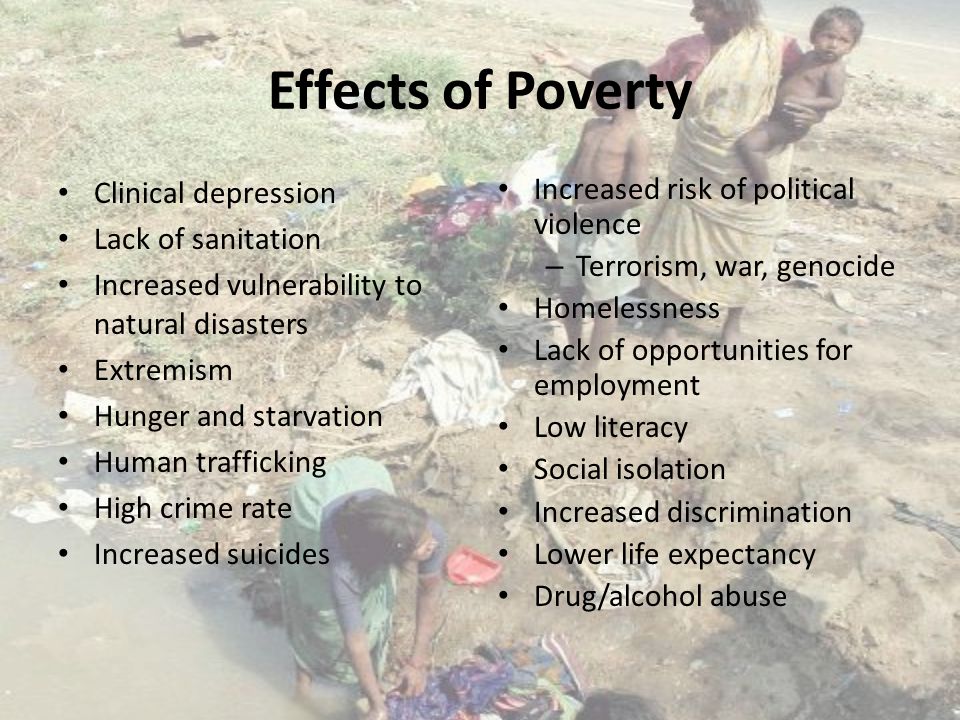
EVALUATION
1. Mention causes of poverty.
2. Mention four programmes organized by African countries to improve food production.
ASSIGNMENT
Objective Test:
1. The major programme for supplying free food to countries in need is A. Food Aid International B. Food International supply C. Feeding Aid International D. International Food Aid E. Food Aiding International.
2. The abbreviation WFP of United Nations means…… A. World Food Proposal B. World Feed Project D. Word Food Programme E. West Food Programme.
3. One major problem in African agriculture is ……. A. no land B. heavy rains C. poor soil D. many people E. no animals.
4 .Food production in some African countries is also seriously affected by……a. too many school books b. political parties D. too many farm workers in farms D. rebels activities and civil wars E. many persons in the countries
5. In the year 2000,the WFP provided ……… of international food aid to Africa. A.2.8 million tons B. 200 million tons C. 10 million tons D. 2.6 million tons E. 2.8 million kilogrammes.
Essay Test:
Read chapter 13 of Junior Secondary Agriculture for Nigerian schools, book 3, and answer revision questions 1 to 5.
REFERENCE TEXT:
Junior Secondary Agriculture for Senior Schools, book 3 by Anthony Youdeowei et al.
TOPIC: CURRENT ISSUES IN AFRICAN AGRICULTURE
CONTENTS: 1. Food crisis in Africa; Hunger and poverty in Africa;
2. Meeting the challenges of African food crisis:
- Hunger and poverty;
- New programmes in African Agriculture
THE FOOD CRISIS IN AFRICA
Factors affecting the ways by which farmers produce food in Africa
1 .Poor soil
2.Unfavorable weather conditions.
3.Pests and diseases.
4 .Poor storage facilities.
5 .Poor transportation systems.
6 .Poor marketing systems: Markets are not well developed.
7 .Inadequate loans and credit facilities.
8. Rebels activities and civil wars e. g civil wars in Somalia ,Sudan ,Sierra Leone Cote’ d Ivoire and Republic of Congo.


HUNGER AND POVERTY IN AFRICA
Africa is referred to as a rural continent .Over 70 percent of the labour in Africa engaged in Agricultural activities. This means that most Africans in the rural areas are farmers, but what they produce is not enough to feed all the people in Africa. Survey in 1997-1999 has shown that about 200 million people {28%) of the entire population of Africa are facing serious shortages of food and therefore they are hungry.
Many African governments spend a lot of money to import food from other countries. Also the governments of rich countries such as USA, England, Canada, France, Germany, and Australia help to supply food free to several chronically hungry African countries especially during emergencies such as drought, famine, floods and civil wars.
The major programmes for supplying free food to hungry countries are known as International Food Aid.

Many African countries receive a lot of food aid. The International Food Aid programme is coordinated by the World Food Programme (WFP).In the year 2000, WFP records shows that Africa received 2.8 million tones of international food aid. Also, south of Sahara desert imported 17 million tons of food to feed its people. Africa Heads of States held a world meeting in Johannesburg, South Africa in the year 2000.They signed a declaration called the Millennium Development Goals (MDGs).One of the goals unitedly agreed upon which concern agriculture, is that the number of hungry people in Africa must be reduced by half (50%) by the year 2015.

EVALUATION: 1. Mention factors affecting the ways by which farmers produce food in Africa.
LESSON 13
MEETING THE CHALLENGES OF AFRICAN FOOD CRISIS: HUNGER AND POVERTY;
NEW PROGRAMME IN AFRICAN AGRICULTURE.
Various programmes organized by African countries to improve food production and remove hunger and poverty include the following:
1 New Partnership for African Development (NEPAD)
2 National Poverty Reduction Strategies.
3 The Special Programme for Food Security: It is organized by Food and Agriculture Organization (FAO) of United Nations.
4 International Funds for Agricultural Development (IFAD)
5 Science, Information and Communication for Agriculture.
6 Nigeria’s programmes for reducing hunger and poverty e.g. National Economic Empowerment and Development Strategy (NEEDS)and States Economic Empowerment and Development Strategy (SEEDS)

CAUSES OF POVERTY
i] Over population.
ii] Unequal distribution of resources.
iii] Inability to meet high standard of living and cost of living.
iv) Environmental degradation.
v) Inadequate education and employment opportunity.
vi) Economic and demographic trend.
vii) Individual responsibility and welfare dependence.

EFFECTS OF POVERTY
-Malnutrition and starvation
-Infectious diseases and exposure to
-Crime and violence
-Mental illness and drug dependence

EVALUATION
1. Mention causes of poverty.
2. Mention four programmes organized by African countries to improve food production.
ASSIGNMENT
Objective Test:
1. The major programme for supplying free food to countries in need is A. Food Aid International B. Food International supply C. Feeding Aid International D. International Food Aid E. Food Aiding International.
2. The abbreviation WFP of United Nations means…… A. World Food Proposal B. World Feed Project D. Word Food Programme E. West Food Programme.
3. One major problem in African agriculture is ……. A. no land B. heavy rains C. poor soil D. many people E. no animals.
4 .Food production in some African countries is also seriously affected by……a. too many school books b. political parties D. too many farm workers in farms D. rebels activities and civil wars E. many persons in the countries
5. In the year 2000,the WFP provided ……… of international food aid to Africa. A.2.8 million tons B. 200 million tons C. 10 million tons D. 2.6 million tons E. 2.8 million kilogrammes.
Essay Test:
Read chapter 13 of Junior Secondary Agriculture for Nigerian schools, book 3, and answer revision questions 1 to 5.
REFERENCE TEXT:
Junior Secondary Agriculture for Senior Schools, book 3 by Anthony Youdeowei et al.
WEEK 9
LESSON 14
TOPIC: AGRICULTURE AND HEALTH
Effects of HIV/AIDS and Malaria in Agricultural production.
HIV/AIDS and Malaria
These are two major diseases that are so important which major national and international programmes are working on various ways to deal with how they affect human survival and development.
HIV/AIDS and Malaria are two diseases very common and wide spread in tropical countries including Nigeria. They are most notable diseases responsible for the death of several people in Africa.
According to the record, HIV/AIDS, alone has killed more people in Africa than all the civil wars put together .About 1million people are known to die of malaria every year and 90% of these deaths occur in Africa including children who should grow into young adults and practice agriculture. HIV/AIDS cannot be cure but malaria can be cured with preventive and curative medicines.
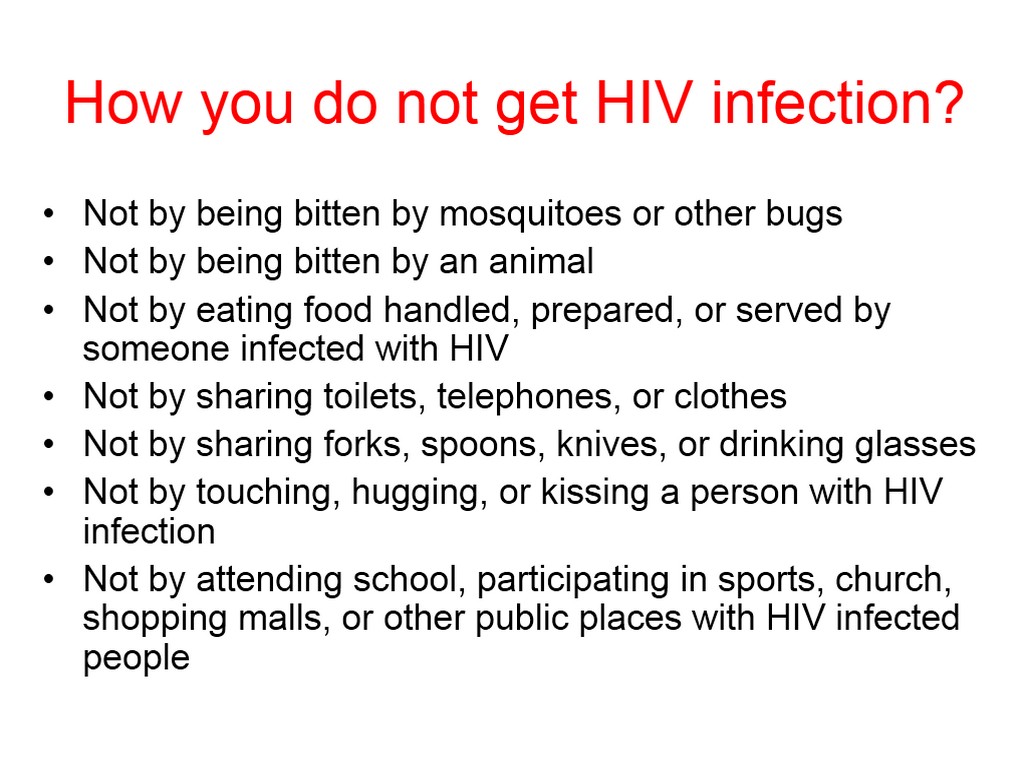
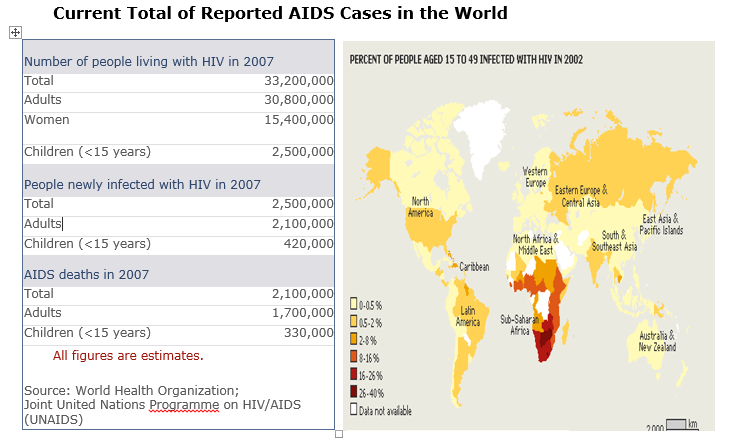

Campaign against HIV/AIDS in schools
HIV/AIDS means Human Immune-deficiency Virus/Acquired Immune Deficiency Syndrome. It is a viral disease commonly transmitted through sexual intercourse.HIV/AIDS belongs to the group of diseases commonly referred to as STD, meaning sexually transmitted diseases.
It is also through the communal use of needles used for infected person for another person who was not infected etc. Over 70% of the 33 million people infected with HIV/AIDS in the world, were in Africa. Since 1985, HIV/AIDS has killed about 7 million agricultural workers in the 25 most affected countries especially Africa. Scientists now believed that by the year2020, it could kill about 16 million agricultural workers.
The United Nations has established UNAIDS to work with national programmes on the HIV /AIDS problem all over the world.
All countries in Africa have established national HIV/AIDS programmes. In Nigeria HIV/AIDS programme is coordinated by the National Agency for the
Control of AIDS (NACA)
The work of NACA includes:
i) .Public awareness activities to inform people about this disease and
ii) How to protect themselves from becoming infected,
ii) How to treat people living with HIV/AIDS and
iv).How to support and look after people who are infected with this disease.
EVALUATION: Mention some of the activities of National Agency for the control of AIDS (NACA) in Nigeria.
LESSON 15
MALARIA
Malaria is a tropical disease caused by a blood parasite, plasmodium, which is transmitted by the female Anopheles mosquitoes. Malaria affects infants and adults. Children less than 5 years and pregnant women are especially at risk of this disease.
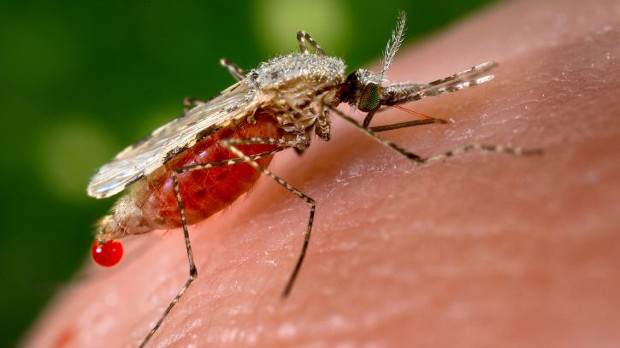
Anopheles Mosquito; carrier of Malaria parasites
WAYS OF MANAGING MALARIA
- Keep the surroundings of your home clean,
-Remove all kind of stagnant water bodies where mosquitoes can breed.
-Sleep in beds cover by mosquito nets or in rooms which have windows and doors covered with mosquito nets.
- Take preventive medicines which are prescribed by doctors.
- Take a full course of treatment medicines prescribed by a qualified doctor
GOVERNMENT EFFORT TO CONTROL MALARIA
All countries affected by malaria have developed national programmes to control malaria e .g Nigeria has established a National Malaria Control Programme, NMCP, Also World Health Organization (WHO) has a major malaria programme called the “Roll Back Malaria Initiative” which is supported by eight world’s richest countries, called G8.
How HIV/AIDS and Malaria Affect Agricultural Production.
i) Reduction in the number of farm workers
ii) It increases death rate
iii) Delay in performing farming activities.
Iv).It increases the number of indigents (orphans and widows)
v).Abandonment of farm business
vi).Economic loss
vii).It leads to reduction in the amount of raw materials available to industries

EVALUATION:
1. List five ways in which HIV/AIDS and malaria affected agricultural production.
2. Mention ways to manage malaria.
ASSIGNMENT:
Objective Test:
1. HIV/AIDS and Malaria are…………..and …………… in the tropical countries. A. very rare and known B. very common and widespread C. very common but limited. D. not common and known. E. not known and seen.
2. The United Nation has established……………….. to work with national programmes of different countries on the HIV/AIDS problem.
A. UNADS B. UNARS C. UNAIDS D. UNADS E. UAIDS
3. Plasmodium is a blood parasite that causes……….A. malaria B. sleeping sickness disease C. HIV/AIDS D. toothache E. backache.
4. The Roll back Malaria Initiative is a programme of the:
A. Food and Agriculture Organization B. Economic Community of West African State, ECOWAS C. Federal Ministry of Internal Affairs D. World Health Organization E. International Labour Organization.
5. Malaria is different from HIV/AIDS because it is caused by ------------- A. a fungus B. a bacterium C. a blood parasite D. a weed E. a roundworm
Essay Test: Explain ways by which HIV/AIDS and malaria has affected agricultural production.
REFERENCE TEXT: Junior Secondary Agriculture for Senior Schools,book 3 by Anthony Youdeowei et al.
TOPIC: AGRICULTURE AND HEALTH
Effects of HIV/AIDS and Malaria in Agricultural production.
HIV/AIDS and Malaria
These are two major diseases that are so important which major national and international programmes are working on various ways to deal with how they affect human survival and development.
HIV/AIDS and Malaria are two diseases very common and wide spread in tropical countries including Nigeria. They are most notable diseases responsible for the death of several people in Africa.
According to the record, HIV/AIDS, alone has killed more people in Africa than all the civil wars put together .About 1million people are known to die of malaria every year and 90% of these deaths occur in Africa including children who should grow into young adults and practice agriculture. HIV/AIDS cannot be cure but malaria can be cured with preventive and curative medicines.



Campaign against HIV/AIDS in schools
HIV/AIDS means Human Immune-deficiency Virus/Acquired Immune Deficiency Syndrome. It is a viral disease commonly transmitted through sexual intercourse.HIV/AIDS belongs to the group of diseases commonly referred to as STD, meaning sexually transmitted diseases.
It is also through the communal use of needles used for infected person for another person who was not infected etc. Over 70% of the 33 million people infected with HIV/AIDS in the world, were in Africa. Since 1985, HIV/AIDS has killed about 7 million agricultural workers in the 25 most affected countries especially Africa. Scientists now believed that by the year2020, it could kill about 16 million agricultural workers.
The United Nations has established UNAIDS to work with national programmes on the HIV /AIDS problem all over the world.
All countries in Africa have established national HIV/AIDS programmes. In Nigeria HIV/AIDS programme is coordinated by the National Agency for the
Control of AIDS (NACA)
The work of NACA includes:
i) .Public awareness activities to inform people about this disease and
ii) How to protect themselves from becoming infected,
ii) How to treat people living with HIV/AIDS and
iv).How to support and look after people who are infected with this disease.
EVALUATION: Mention some of the activities of National Agency for the control of AIDS (NACA) in Nigeria.
LESSON 15
MALARIA
Malaria is a tropical disease caused by a blood parasite, plasmodium, which is transmitted by the female Anopheles mosquitoes. Malaria affects infants and adults. Children less than 5 years and pregnant women are especially at risk of this disease.

Anopheles Mosquito; carrier of Malaria parasites
WAYS OF MANAGING MALARIA
- Keep the surroundings of your home clean,
-Remove all kind of stagnant water bodies where mosquitoes can breed.
-Sleep in beds cover by mosquito nets or in rooms which have windows and doors covered with mosquito nets.
- Take preventive medicines which are prescribed by doctors.
- Take a full course of treatment medicines prescribed by a qualified doctor
GOVERNMENT EFFORT TO CONTROL MALARIA
All countries affected by malaria have developed national programmes to control malaria e .g Nigeria has established a National Malaria Control Programme, NMCP, Also World Health Organization (WHO) has a major malaria programme called the “Roll Back Malaria Initiative” which is supported by eight world’s richest countries, called G8.
How HIV/AIDS and Malaria Affect Agricultural Production.
i) Reduction in the number of farm workers
ii) It increases death rate
iii) Delay in performing farming activities.
Iv).It increases the number of indigents (orphans and widows)
v).Abandonment of farm business
vi).Economic loss
vii).It leads to reduction in the amount of raw materials available to industries

EVALUATION:
1. List five ways in which HIV/AIDS and malaria affected agricultural production.
2. Mention ways to manage malaria.
ASSIGNMENT:
Objective Test:
1. HIV/AIDS and Malaria are…………..and …………… in the tropical countries. A. very rare and known B. very common and widespread C. very common but limited. D. not common and known. E. not known and seen.
2. The United Nation has established……………….. to work with national programmes of different countries on the HIV/AIDS problem.
A. UNADS B. UNARS C. UNAIDS D. UNADS E. UAIDS
3. Plasmodium is a blood parasite that causes……….A. malaria B. sleeping sickness disease C. HIV/AIDS D. toothache E. backache.
4. The Roll back Malaria Initiative is a programme of the:
A. Food and Agriculture Organization B. Economic Community of West African State, ECOWAS C. Federal Ministry of Internal Affairs D. World Health Organization E. International Labour Organization.
5. Malaria is different from HIV/AIDS because it is caused by ------------- A. a fungus B. a bacterium C. a blood parasite D. a weed E. a roundworm
Essay Test: Explain ways by which HIV/AIDS and malaria has affected agricultural production.
REFERENCE TEXT: Junior Secondary Agriculture for Senior Schools,book 3 by Anthony Youdeowei et al.